Late 2020 Retrospective
By Brian Wilson
I last did some catching up of recordings which my colleagues had reviewed
back in the Summer of 2020, so there’s plenty of ground to make up. I’m
concentrating especially on albums which have received the Recommended, Recording of
the Month or Recording of the Year accolade.
Index
Bach
Musical Offering – Ensemble Sonnerie: Erato; Suzuki: BIS
- Art of Fugue – Rasi: Challenge Classics
- St John Passion – Suzuki: BIS
Beethoven
Piano Concertos – Hough: Hyperion; Goodyear: Orchid
- Piano Concerto 3, Triple Concerto – Helmchen: Alpha
Ben-Haim
Symphony No.1, etc. – Wellber: Chandos
Blackford
Blewbery Air – Wallfisch, Farmer: Nimbus
Britten
Peter Grimes – Bedford; Signum
Copland
Symphony No.3 – Tilson Thomas: SFS Media
 Debussy
Images, etc – Elder: Hallé
Debussy
Images, etc – Elder: Hallé
Delibes
Ballet Suites – Järvi: Chandos
Devienne
Trios – Le Petit Trianon: Ricercar
Dohnányi
– Piano Quintets, String Quartet – Takács Quartet: Hyperion
Dowland
A Fancy – Zuljan: Ricercar
Dunhill, D’Erlanger
Piano Quintets – Lane, Goldner Quartet: Hyperion
Dvořák
Cello Concerto, etc. – Soltani: DG
Handel Concerti Grossi, Op.3 – Kallweit: Pentatone; Goodman: Hyperion
- Samson – Butt: Linn; Alarcón: Ricercar
Hillier
Piano Concertos – Shelley: Hyperion
 Howells
– see Stanford
Howells
– see Stanford
Jančeviskis
Choral Music – Cábulis: Hyperion
Josquin
Masses – Tallis Scholars: Gimell
MacMillan Symphony No.4; Viola Concerto – Brabbins: Hyperion
Mahler
Symphony No.7 – Gergiev: LSO Live
Mäntyjärvi
Choral Music – Trinity College Cambridge: Hyperion
Fanny Mendelssohn
Piano Trios (with Clara Schumann) – Nash Ensemble: Hyperion
Monteverdi
Vespers – Bestion: Alpha
Mozart
y Mambo – Willis: Alpha
Mozart Gran Partita - Ogrintchouk: BIS
Picchi
Canzoni – Genini: Arcana
Prokofiev
Symphonies 1-3 – Litton: BIS
Clara Schumann
Piano Trio (with Fanny Mendelssohn)
Shostakovich
Violin Concertos – Ibragimova: Hyperion
- Symphony No.13 ‘Babi Yar’ – Karabits: Pentatone
Sibelius
Symphony No.2; King Christian II Suite – Rouvali: Alpha
 Stanford and Howells
Remembered – Rutter: Collegium
Stanford and Howells
Remembered – Rutter: Collegium
Strauss Family
Memories of Vienna – Krips: Decca Eloquence
Tallis
– Spem in alium, etc. – Ora Singers: Harmonia Mundi
Tavener The Protecting Veil - Barley: Signum
-
No longer mourn for me and other works for cello - Isserlis:
Hyperion
Tchaikovsky
Symphony No.5, Francesca da Rimini – Paavo Järvi: Alpha
Vaughan Williams
Symphony No.1 – Manze: Onyx
- Symphonies Nos. 3 and 4 – Brabbins: Hyperion
- Symphony No.5; Pilgrim’s Progress Secene – Barbbins: Hyperion
- Job; Songs of Travel – Elder: Hallé
Anonimo Venexian
– d’Avena/Ribeiro: Ramée
Banquet of Voices
– Rutter: Collegium
British Violin Sonatas 3
– Little, Lane: Chandos
Carols from King’s 2020
Lament
– Ensemble Allegria, etc.: BIS
Spohr Collection
– Historical Flutes: Channel Classics
***
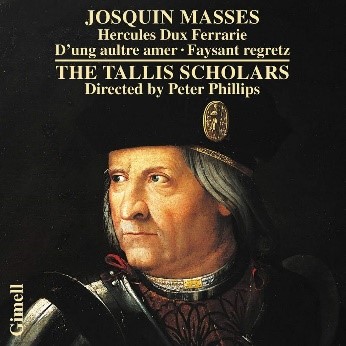 Recording of the Year
Recording of the Year
JOSQUIN Des Prés (c.1450-1521)
Missa Hercules Dux Ferrariæ
(1503/4? ed. Timothy Symons) [27:29]
Missa d’ung aultre amer
(ed. Thomas Noblitt), including Tu solus qui facis mirabilia and D’ung aultre amer (ed. Bonnie Backburn) [17:52]
Missa Faysant regretz
(ed. Timothy Symons) [26:18]
The Tallis Scholars/Peter Phillips
rec. Merton College Chapel, Oxford. 2019?
Texts and translations included; scores of Missa Hercules Dux Ferrariæ and Missa Faysant regretz
available from gimell.com.
Reviewed as 24/96 download with pdf booklet from
hyperion-records.co.uk.
Also available in 16-bit, 24/176.4 and on CD.
GIMELL CDGIM051
[71:36]
Yes, I’ve reviewed this in detail and chosen it as the first of my
Recordings of the Year, but I can’t praise it and the series of Josquin
recordings which it crowns too highly. My excuse for saying so again in a
Retrospective is
that John Quinn has also
reviewed it and praised the whole achievement.
Somewhere in the dark backward and abysm of time, where the snows of
yesteryear may, perhaps, still be found, I
reviewed
the first of the Tallis Scholars’ recordings of the Masses of Josquin to
have come my way. It wasn’t my first encounter with Peter Phillips and his
team – that was from their first-ever recording, originally released on
Classics for Pleasure and, most recently, as a hi-res download – and I had
been an admirer ever since. I made it a Recording of the Month, and I’ve
been adding accolades ever since, both for their CDs and for two of their
concerts.
Now, with the release of the final album in their Josquin series, is a good
time to renew my praise of CDGIM039 and those that preceded and followed.
Also, to remind readers that, whereas Gimell used to host their own
downloads, for some time now their downloads and CDs have been available
from Hyperion, a very happy symbiosis of two labels with very high
standards.
I chose the mp3 download of CDGIM039 originally, probably because I was still on
dial-up broadband. The 24-bit from
hyperion-records.co.uk
is in every way superior, downloaded in minutes with a fibre connection,
and, at £12, not exorbitantly expensive. (16-bit is £7.99, CDs are £11.75).
Whichever you choose, this is even more desirable in superior sound.
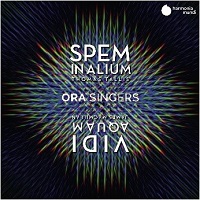 Recording of the Year
Recording of the Year
Spem in alium
ORA Singers/Suzi Digby
rec. 2019, All Hallows’, Gospel Oak, London
Latin texts and English & French translations included
Includes DVD - ‘Spem in alium: 450 years’
Reviewed as 24/96 download from
eclassical.com.
Also available from
eclassical.com
in binaural ‘3D’ stereo (headphones only).
HARMONIA MUNDI HMM902669.70
[CD: 70:24 + DVD: 35 mins]
For CD purchase details see
review.
Stream from
Naxos Music Library
John Quinn
reviewed
the physical product on CD and DVD with enthusiasm; the download contains
the music on the CD only, but is available in superior 24/96 sound,
especially valuable when the programme opens and closes with dense 40-part
textures. This is definitely not one to economise on by choosing mp3.
The programme opens with an astoundingly good performance of the
Tallis 40-part
motet, which we still don’t have a definite date or occasion for, perhaps
Queen Mary’s fortieth birthday, or that of Queen Elizabeth. Ora hedge their
bets, saying that it’s ‘around’ 450 years old. No excuse is needed for
giving us such a fine recording of this breath-taking work, which many
believe was inspired by Tallis’s commission to outdo a 40-part motet by
Striggio – see Download of the Month in
DL Roundup April 2011/2.
I can’t say that Ora are outright winners here, when there are so many fine
performances, not least from I Fagiolini and Robert Hollingsworth on the
Decca recording of the Striggio, The Sixteen (Coro CORSACD16016), The
Taverner Choir (Veritas 5622302, super-budget twofer) and The Tallis
Scholars (Gimell CDGIM006, or – better value – CDGIM203, 2-for-1). Ora take
a little longer than most to make their point, but their performance ranks
alongside the three that I have selected. The Veritas and Gimell albums
both offer other music by Tallis, while the Coro, like the new Harmonia
Mundi, sets Tallis in the company of other composers who wrote music for
‘Monarchs and Magnates’.
There may no longer be aristocrats with deep purses to commission music,
but the Harmonia Mundi programme ends with the modern equivalent, and that makes the new
recording very special. Sir James MacMillan’s setting of Vidi aquam, commissioned by ORA, who here give its premiere
recording, neatly sets off the Tallis: both are in 40 parts, and the new work demonstrates a clear line of descent from the
composers of the English and Scottish renaissance. MacMillan has a
particular affinity with the Scottish Robert Carver, a composer
comparatively neglected by comparison with his contemporaries South of the
border. (Just one recording totally devoted to his music, from The Sixteen,
Coro COR16051 –
Spring 2020/2).
Without sounding in any way derivative, Vidi aquam comes as close
as any modern composition is likely to come to mirroring the music of the
renaissance. If I say that there’s less challenge here than usual for
traditionalists – for whom MacMillan’s music can sometimes be demanding –
that doesn’t mean that it sounds at all facile. I’ve been warming more and
more to MacMillian’s music recently, including a Coro recording of Symphony
No.5 and The Sun Danced –
review
–
review
– and Symphony No.4 and Viola Concerto –
review
–
review.
Vidi aquam has certainly contributed to the process.
By coincidence, another recording has recently appeared on which a modern
composer responds to the music of the past. There Michael Finnissy
has worked with the choir of St John’s College, Cambridge to produce a
series of vocal and organ works which relate to their extensive repertoire.
On Signum SIGCD624, he responds to music from Taverner to Bach, including
Tallis’s Videte miraculum. There, the thread connecting the music
of the past and present is often very tenuous, and the result is something
of a mixed blessing –
review.
Listening to MacMillan’s response to Tallis’s 40-part motet, I think that
part of his greater success lies in the fact that he isn’t setting the same
words as his predecessor or trying to respond to a specific set of notes,
but rather to produce an independent work which nevertheless relates to
what has gone before. I take it to be deliberate that he chose the
Eastertide text for the asperges, Vidi aquam, because no setting
of it survives from Tallis, so that there is no temptation to echo a
particular musical theme. There are, however, several settings of that text by Iberian
composers.
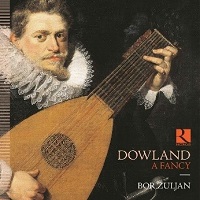 John DOWLAND (1563-1626) ‘A Fancy’
John DOWLAND (1563-1626) ‘A Fancy’
A Fantasia (P71) [7:04]
A Dream [5:16]
A Fancy (P73) [3:16]
Can She Excuse: the Right Honourable Robert, Earl of Essex, His
Galliard [2:55]
Preludium [1:13]
A Fancy (P5) [2:37]
Lachrimæ [5:16]
Forlorn Hope Fancy [3:48]
Galliard to Lachrimæ [2:18]
A Fancy (P6) [2:58]
Monsieur’s Almain [4:56]
A Fantasie (P1a) [3:57]
The Right Honourable the Lady Clifton’s Spirit [1:45]
Lady Hundson’s Puffe [1:01]
Sir John Smith, His Almain [2:29]
Fortune [2:51]
A Fancy (P7) [5:20]
Farewell [6:57]
Bor Zuljan (8-course lute)
Lute in F after Venere 1582 by Jiří Čepelák (Prague, 2012)
Gut strings by Corde Drago
rec. Saint-Germain Church, Geneva, Switzerland, February 2020
RICERCAR RIC425 [61:57]
For CD purchase details see
Recording of the Month review.
Stream from
Naxos Music Library
Lutenists have progressed considerably in technique and understanding
since Julian Bream was one of the first guitarists to turn to the older
instrument, but I still frequently return to his ground-breaking The Lute Music of John Dowland
(Sony G010002996339J, download only) and The Woods so Wild (Byrd,
Cutting, Dowland, etc., Sony G010002996237V, download only). These and his
other surviving lute recordings offer short playing times, but can be
obtained for around £8.50 in lossless sound – see
Retrospective Summer 2020
and
DL News 2014/12.
Then, of course, there are more recent recordings from the likes of Nigel
North (three inexpensive but highly regarded Naxos recordings) and Paul
O’Dette (Hyperion and Harmonia Mundi).
One clear advantage of the new Ricercar recording comes from the very good
notes in the booklet, by Bor Zuljan himself – the Sony downloads are
innocent of any such. By sheer coincidence, these performances, recorded on
the very eve of the pandemic, capture the mood of 2020, with their emphasis
on Dowland’s melancholia – real or fashionable, like his excuse that he
could obtain no advancement in England because of his ‘conversion’ to Roman
Catholicism. It’s not just a matter of tempo – Bream is sometimes slower –
or the deeper tone of Zuljan’s lute; the appeal of this recording is inherent
in his vision of the music.
Glyn Pursglove in his review gives several examples of the fashionable
melancholy of the time. My own favourite is John Aubrey, who in the preface to
his collection of biographies Brief Lives, reports that he was
melancholy in the womb. Even Dowland couldn’t beat that.
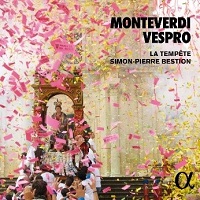 Recording of the Year
Recording of the Year
Claudio MONTEVERDI (1567-1643)
Vespro Della Beata Vergine, SV206 (1610 – arranged and edited Simon-Pierre Bestion 2018)
Claire Lefilliâtre (soprano); Fiona McGown (mezzo-soprano); Eugénie de Mey
(alto); Francisco Mañalich, Sébastien Obrecht, Pierre-Antoine Chaumien
(tenors); Renaud Bres, Arnaud Richard (basses)
La Tempête/Simon-Pierre Bestion
rec. 2018, Notre Dame du Liban, Paris. DDD.
Full texts and translations included
ALPHA 552
[2 CDs: 142:07] For CD purchase see
review.
Stream from
Naxos Music Library.
This is where I have to part company to the greatest possible
extent with
my colleague Richard Hanlon – and with most other reviews that I have read.
This is decidedly not my Recording of the Year, or any day of it, as I
wrote in
Autumn 2019/1.
It’s as great a piece of vandalism as if someone had taken a crayon and
drawn some extra bits on one of my favourite Venetian paintings, then added
some glitter.
There’s a very fine line between looking afresh at the music of the past
to make it more easily available – the Swingle Singles, for example –
and destroying it. For me, this joins all too many recent recordings where
it’s been thought clever to upset the apple cart. It used to be just opera
productions, now it’s the music of Monteverdi and Vivaldi, the latter’s La Tempesta di Mare concerto destroyed by bolting on primeval
howlings derived from Pirates of the Caribbean in Patricia
Kopatchinskaja’s recent recording, also from Alpha, and also much praised,
but not by me. (ALPHA624 –
review). The really annoying thing is that both recordings enshrine some very
fine performances.
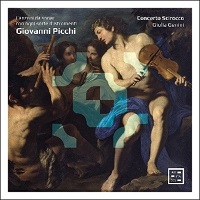 Giovanni PICCHI (1572-1643)
Giovanni PICCHI (1572-1643)
Canzoni da sonar con ogni sorte d’istromenti
(Venice 1625)
Concerto Scirocco/Giulia Genini
rec. 18-22 August 2018, Chiesa di Santa Marta, Carona, Switzerland; 5-6
December 2019, Sala della Carità, Padua, Italy. DDD.
Pitch: a’=466Hz, Meantone temperament 1/4-comma
Reviewed as lossless (wav) press preview.
ARCANA A476
[71:29]
For full details, including CD purchase links, please see
review
by Johan van Veen.
Stream from
Naxos Music Library.
Music for, as the title says, ‘all kinds of instruments’.
Though best known
as a keyboard player and composer – and even in that field not well
represented on record – Picchi shows his skills in writing for varied
ensembles, and Concerto Scirocco commend the music to us in fine
performances. There’s plenty of scope for the wind instruments, so it’s
quite appropriate that the performers are called Concerto Scirocco, though
their playing is more pleasing than the effects of the sand-laden wind
after which they are named. (Or perhaps they had the VW sports car in
mind.) Not just one for the cognoscenti. There are just a few rival recordings
of any of these canzoni, as, for example, the double-choir No.10
from Robert Woolley, the Purcell Quartet, and His Majestys Sagbutts and
Cornetts, with music by Frescobaldi, Marini and others on Chandos (Capriccio stravagante, Volume 1 – CHAN0651).
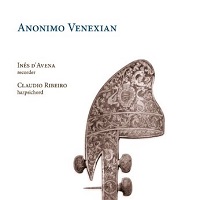 Recording of the Year
Recording of the Year
Anonimo Venexian
Antonio VIVALDI (1678-1741)
(attr.)
Sonata per Flauto in F [10:44]
Francesco GASPARINI (1661-1727)
(attr.)
Suonata Per spinetta divetta Per S.I. in A [4:31]
Diogenio BIGAGLIA (c.1676-c.1745)
Sonata V in e minor, Op. 1/5 [10:07]
Anon
Suonata in D [6:35]
Sonata per Flauto in B flat [9:59]
Francesco GASPARINI
Toccata di spinetta Per Sig:ra Isabella del Sig:or F:co G:ni in D [5:42]
Diogenio BIGAGLIA
Sonata II in G, Op. 1/2 [11:06]
Anon
Sinfonia 2 in C [8:32]
Sonata à Flauto solo in C: adagio [4:41]
Inês d’Avena (recorder)
Claudio Ribeiro (harpsichord)
rec. 2018, Sala della Musica dell’Ospedaletto, Venice. DDD
Reviewed as streamed in 24/88.2
RAMÉE RAM1905
[72:02]
For CD purchase details see
review.
Stream from
Naxos Music Library.
I’d describe this as very enjoyable rather than an essential purchase, but
musicologists and lovers of the recorder will be delighted at the wealth of
unknown music from Venice’s golden age unearthed by these two performers
during forty days in the Autumn of 2018. One to check out from
Naxos Music Library
first, perhaps.
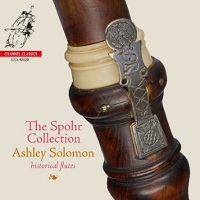 The Spohr Collection: Historical Flutes
The Spohr Collection: Historical Flutes
Jacques MOREL (1700-1749)
Chaconne en trio
(flute, viola da gamba, theorbo) [6:25]
Johann Sebastian BACH (1685-1750)
Organ Trio Sonata BWV525 in G (flute, harpsichord) [13:53]
Jean-Marie LECLAIR (1697-1764)
Sonata No.V in G, Op.1 (flute, viola da gamba, theorbo, harpsichord)
[10:09]
Jacques HOTTETERRE le Romain (1674-1763)
Ornamented Airs and Brunettes (flûte d’amour, viola da gamba, theorbo)
[6:56]
Jean-Baptiste BARRIERE (1707-1747)
Sonata a tre
No.2 in d minor (flute, viola da gamba, theorbo, harpsichord) [8:18]
Georg Philipp TELEMANN (1680-1767)
Fantasia No.8 in e minor, twv40:9 (solo flute) [4:18]
Methodical Sonata No.3 in e minor, twv41:e2 (flute, viola da gamba theorbo,
harpsichord) [10:52]
Pietro LOCATELLI (1695-1764)
Sonata in C Op.2, No.1 (flute, harpsichord) [8:41]
Ashley Solomon (flute), David Miller (theorbo), Reiko Ichise (viola da
gamba), Julian Perkins (harpsichord)
rec. Remonstrantse Kerk, Renswoude, December 2019. DDD/DSD
Historical flutes by Chattillion (c.1680), J. Denner (c.1725), Naust
workshop (c.1730), Paulhahn (c.1735), Fortier (c.1720), Hemsing (c.1725);
flûte d’amour by J. Denner (c.1725); ivory flute with a silver key, Senior
workshop (c.1725), ivory flute with a silver key by G.H. Scherer (c.1750)
Viola da gamba: Copy of 7-string Bass Viol, after Barbey, Paris 1720, by D.
Rubio, 1986; Theorbo by Martin Haycock, 1995, after Italian models;
Two-manual harpsichord after Mietke, Bruce Kennedy, 1989 (collection Menno
van Delft, Amsterdam).
Reviewed as 24/96 press preview.
CHANNEL CLASSICS CCS43020
[69:45]
For details and SACD purchase links please see Recommended review by
Johan van Veen,
‘This is a very fine disc, which … may especially appeal to lovers and
players of the flute [but] is also a fascinating sounding documentation of
some outstanding instruments and the art of their makers’.
Let’s get one thing clear from the start, to avoid any confusion: none of
the music here was composed by the composer Louis Spohr. It’s named after a private
collection of flutes in Frankfurt, including what flautist Ashley Solomon
describes as ‘some of the finest examples of playable baroque flutes
anywhere at the time of their manufacture’. I’ve listed the instruments in
the details above, and there are photos of, and notes on, each of them in
the booklet.
In fact, the instruments are the main point of this recording, with the
music carefully chosen to match each of them. In the process, however, we
have what amounts to an enticing programme of works from eighteenth-century
composers. If it leads listeners to investigate further the music of these
composers, some of them not well known, so much the better. The opening
Morel Chaconne, for example, may lead you to explore a
budget-price Brilliant Classics album of his Première livre de pièces de violle which concludes with the same
piece (95962, Alejandro Marías (viola da gamba) and La Spagna –
review).
The odd man out in this collection is JS Bach; though he wrote for the
flute, including the sonatas BWV1030-5, which Ashley Solomon has already recorded
for Channel Classics, the Trio Sonata on tracks 2-4 was composed for the
organ. A purist view would be that music should always and only be
performed on the instrument(s) for which it was composed, but composers
themselves often made different arrangements of their own music, and I see
no reason why three-part writing for the organ should not be redistributed
to a solo flute and two hands at the harpsichord.
Heresy or not, it works well in this fine performance, though I wouldn’t
imagine that less accomplished players could bring it off. I’m a purist
when it comes to insisting that Bach’s music for the harpsichord should
always be performed on that instrument, until I hear Angela Hewitt on the
piano. The Trio Sonata has been transposed from E-flat to G, a more
suitable key for the flute, but, again, I’m quite happy with that, and,
indeed, with all the performances on this very fine recording.
There has been a recent series of fine recordings of flute music from the
baroque and the eighteenth century – including the Devienne reviewed below. Don’t
overlook this one because it looks academic; it’s much more than that.
Anyone with an interest in the early history of the flute should check out
this recording of the instruments from a splendid collection of wooden and
ivory baroque instruments, some resplendent with silver keys, illustrated
with fine performances of appropriate music.
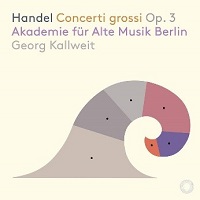 Recording of the Year
Recording of the Year
George Frideric HANDEL (1685-1759)
Concerti grossi, Op.3, HWV313-317 (1734)
No.1 in B-flat, HWV312 [7:44]
No.2 in B-flat, HWV313 [10:08]
No.3 in G, HWV314 [8:01]
No.4 in F, HWV315 [12:03]
No.5 in d minor, HWV316 [9:32]
No.6 in D, HWV317 [6:30]
Akademie für Alte Musik Berlin/Georg Kallweit
rec. Nikodemuskirche, Berlin, May 2019. DDD/DSD.
Reviewed as streamed in 24/96 stereo.
PENTATONE PTC5186776 SACD
[54:11]
For CD purchase details see
review.
Stream from
Naxos Music Library.
This is a very attractive follow-up to the Akademie’s two
earlier SACDs of
Handel’s Op.6, which I thought exceptionally bright and lively –
review.
If you enjoyed either or both of those, you will almost certainly relish
their successor. Equally bright and lively, and just as well recorded, as
heard in 24/96 sound, I was strongly tempted to make this a Recommended
recording, so I'm glad that one of my coleagues did. I held back only because there are equally fine versions to be
had, though not on SACD or in hi-res sound.
Originally published in a pirate edition by Walsh, perhaps from odds and
ends of music by Handel, the Op.3 set is nevertheless very attractive. The
practice of ‘borrowing’ music from other works was common at the time:
Handel and Bach, and many others, re-fashioned their own music regularly.
Though the later, larger, Op.6 set, a genuine publication, contains Handel’s
more mature works, Op.3 probably has a more immediate appeal for most
listeners.
Better value can be obtained from The Brandenburg Consort and Roy Goodman
on Hyperion Helios:
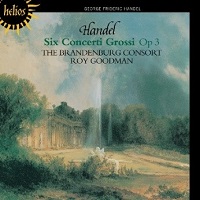 Concerti Grossi, Op.3/1-6, HWV312-317
Concerti Grossi, Op.3/1-6, HWV312-317
Concerto in F, Op.3/4b
Organ Concerto Movement in d minor, HWV317/ii
The Brandenburg Consort/Roy Goodman
rec. June 1992. DDD.
HYPERION HELIOS CDH55075
[76:34]
See original
review.
Does the new Pentatone SACD and 24-bit recording give the green light to throw
out my copy of this on CD,
bearing in kind that it’s available to download in lossless sound for £7.99
from
hyperion-records.co.uk,
with a pdf copy of the booklet? It’s also available there on CD for £8.
Price considerations apart, it includes both versions of No.4, the one
originally published by Walsh (4b) and the one which Handel replaced it with
when he legitimised the publication (4a). It also includes a movement for
organ and orchestra, bringing the playing time to a healthy 75:21, so it's a
keeper along with the new Pentatone.
Though Handel rejected the original No.4 and scholars believe it to be a
rag-bag from various sources, I rather like it; you can always leave it out
if you don’t agree. That was my reason for preferring the Hyperion even to
the very fine versions from the likes of Richard Egarr (Harmonia Mundi,
download only). Available in lossless sound for around £10, however, Egarr’s
recording also adds extra music: not No.4b, but a Sonata a5, HWV288.
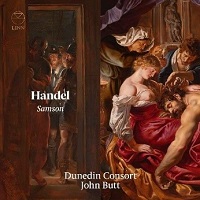 George Frideric HANDEL (1685-1759)
George Frideric HANDEL (1685-1759)
Samson
(1743 version)
Samson - Joshua Ellicott (tenor)
Micah - Jess Dandy (alto)
Manoa - Matthew Brook (bass)
Harapha - Vitali Rozynko (bass)
Dalila - Sophie Bevan (soprano)
Israelite/Philistine/Messeger - Hugo Hymas (tenor)
Virgin/Israelite Woman/Philistine Woman - Mary Bevan (soprano)
Virgin/Philistine Woman - Fflur Wyn (soprano)
Tiffin Boys’ Choir
Dunedin Consort/John Butt (harpsichord)
rec. 2018, St Jude-on-the-Hill, Hampstead Garden Suburb, London
Reviewed as lossless press preview.
LINN CKD599
[3 CDs: 204:14] For CD purchase details see Recommended
review
–
review.
I’ve included this excellent recording mainly for the sake of contrast with
another recent recording, this time of the 1741 version. There really
is no comparison:
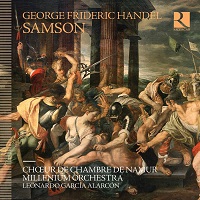 Matthew Newlin (tenor) - Samson
Matthew Newlin (tenor) - Samson
Klara Ek (soprano) - Dalila
Lawrence Zazzo (counter-tenor) - Micah
Luigi Di Donato (bass) - Manoah / Harapha
Julie Roset (soprano) - Philistine Woman / Israelite Woman
Maxime Melnik (tenor) - Messenger / Philistine
Chœur de Chambre de Namur
Millenium Orchestra/Leonardo García Alarcón
rec. live Festival Musical de Namur, Église Saint-Loup, 4 July 2018. DDD.
Texts included.
Reviewed as lossless (wav) press preview
RICERCAR RIC411
[73:35 + 75:09]
‘George Frideric Handel: Samson’, it says on the cover – but what
you see is not exactly what you get; this is a heavily abridged recording,
encompassing only about two thirds of the work, a fact admitted in the
notes, though not prominently displayed: ‘The oratorio was performed in
several versions even during Handel’s lifetime; Leonardo Garcia Alarcon has
opted for the same choices as those made by Nikolaus Harnoncourt, believing
them to be the best. The work of this legendary conductor has been our
direct inspiration for this recording, which is also our homage to him’.
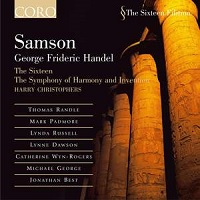 Be that as it may, completists will need to look elsewhere, which means
running to three CDs, as from John Butt and the Dunedin Consort (above) or The Sixteen
and Harry Christophers – reviewed as lossless (flac)
download with pdf booklet from
thesixteenshop.com.
CORO COR16008 [3:24:49] –
review.
Those happy with Harnoncourt’s truncation – not ‘complete’, as claimed in
the final edition of the Penguin Guide – will find his own recording for a
fraction of the price of the new Ricercar (Warner Teldec 2564692602, around
£8.50).
Be that as it may, completists will need to look elsewhere, which means
running to three CDs, as from John Butt and the Dunedin Consort (above) or The Sixteen
and Harry Christophers – reviewed as lossless (flac)
download with pdf booklet from
thesixteenshop.com.
CORO COR16008 [3:24:49] –
review.
Those happy with Harnoncourt’s truncation – not ‘complete’, as claimed in
the final edition of the Penguin Guide – will find his own recording for a
fraction of the price of the new Ricercar (Warner Teldec 2564692602, around
£8.50).
There are two versions of the Linn recording. CKD599, available on CD and
as a download, employs a full chorus, with both sopranos and trebles, an
unusual combination but one to which Handel would have been accustomed. For
those who prefer a smaller chorus, the eight soloists only, plus an extra
alto, there is also a digital-only version (CKD629). I refuse to be
dogmatic on this subject – both arrangements work well in the right hands,
in Bach and Handel, and John Butt’s are some of the best hands in the
business, as demonstrated by his earlier recordings for Linn.
Butt’s notes offer evidence for Handel's use of the soloists alone in the chorus of Messiah, but both versions work well for me. He also adduces
evidence for the soloists alone in Samson, but, at the risk of
accusations of fence-sitting, I retain my agnosticism in the light of
hearing and enjoying both versions of the new recording.
Another consequence of Butt’s decision to record the 1743 edition is
potentially more serious in that there is no funeral march after the death
of Samson. Handel composed one, but seems never to have used it, and later
added the familiar Dead March from Saul. Harry Christophers
includes the latter, so his must be your version of choice if you must have
the march. Handel was, of course, much given to changing things
around – the first version of Judas Maccabæus didn’t include the
famous ‘See the conqu’ring hero comes’ – so it should come as no surprise
that there is no march. It’s by no means a clincher for me, but I did
wonder if we might have been a little less purist – or even had the march
as an optional addition. That apart, I could be very happy with either
Butt or Christophers – but not with the Ricercar: a rare misfire for this label.
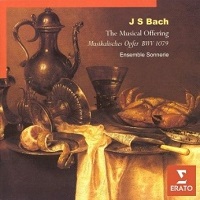 Johann Sebastian BACH (1685-1750)
Johann Sebastian BACH (1685-1750)
Das musikalische Opfer
(Musical Offering), BWV1079 [71:44]
Ensemble Sonnerie [Pavlo Beznosiuk (viola), Frances Eustace (woodwinds),
Paul Goodwin (oboe), Monica Huggett (violin), Sarah Cunningham (viol), Gary
Cooper (harpsichord), Wilbert Hazelzet (flute)]
rec. May 1994. DDD.
ERATO 545139-2
[71:44]
There’s a reminder and a warning lesson here. Though I haven’t reviewed
this recording before, I did mention it in connection with a Somm CD of the Offering as the best version that I knew: the performance ‘raises
all the music to a level of enjoyment that I’d derived only from the Trio
Sonata before’ –
review.
Had you followed
my advice then, you could have had this on CD;
now it seems to be available only as a
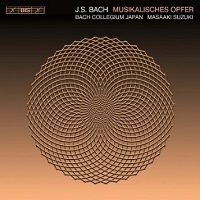 download, without a booklet, and
costing almost £13 in lossless sound – more than you might have expected to
be charged for the CD. It pays to go for what you want as you can afford; Warner are not alone
in having made many fine recordings download only, but they slaughtered half the Virgin Classics catalogue on disc when they
took it over and renamed it Erato.
download, without a booklet, and
costing almost £13 in lossless sound – more than you might have expected to
be charged for the CD. It pays to go for what you want as you can afford; Warner are not alone
in having made many fine recordings download only, but they slaughtered half the Virgin Classics catalogue on disc when they
took it over and renamed it Erato.
Consolation, however, is at hand in the form of a recording by the Bach
Collegium Japan and Masaaki Suzuki for BIS – available on SACD and as a 16-
and 24-bit (stereo and surround) download from
eclassical.com
(BIS-2151). Michael Cookson found that ‘decidedly recommendable’ –
review
– and Dave Billinge wrote that it ‘should be added to your collection’ –
review.
I see that I thought the BIS ‘marginally … cerebral’ (Autumn 2017/2), but, on reflection, it makes a good replacement for the Erato. The sound
– brighter-toned than the Erato – is well captured in 24/96
quality.
Stream from
Naxos Music Library.
 Johann Sebastian BACH (1685-1750)
Johann Sebastian BACH (1685-1750)
Die Kunst der Fuga, BWV1080 (from MS Bach P200, 1742-1750)
Accademia Strumentale Italiana/Alberto Rasi (treble viol)
rec. Nazareth Church, Verona, Italy, 13 September 2019. DDD.
CHALLENGE CLASSICS CC72842
[68:22]
For CD purchase details see
review
I’ve already had my say on this at length, but it was gratifying to
read Dominy Clements’
review,
demonstrating that we’re substantially in agreement that this is a
recording to return to. It’s also a reminder that you often get two
opinions, or more, on MusicWeb – sometimes in agreement, as here, and
sometimes not, but supported by the evidence to make your own minds up.
Johann Sebastian BACH (1685—1750)
Johannes-Passion, St John Passion, BWV245 (1739/49 version) [104:55]
James Gilchrist (tenor) – Evangelist
Hana Blažíková (soprano)
Damien Guillon (alto)
Zachary Wilder (tenor)
Christian Immler (bass) — Jesus
Aki Matsui – Maid
Yosuke Taniguchi – Attendant
Chiyuki Urano – Peter
Yusuke Watanabe – Pilate
Bach Collegium Japan Chorus and Orchestra/Masaaki Suzuki
rec. 14—17 March 2020, Kölner Philharmonie, Germany. DDD/DSD.
Reviewed as 24/96 download with pdf booklet from
eclassical.com.
BIS BIS-2551 SACD
[2 SACDs 31:53 + 73:15]
For SACD purchase details see
Recommended review.
Stream from
Naxos Music Library.
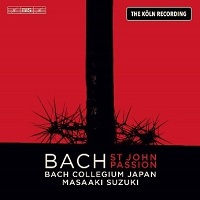 This is the St John Passion recording that almost didn’t happen.
Cologne was the fourth stop on the Bach Collegium Japan’s
thirtieth-anniversary tour with this performance of the St John,
due on 10 March 2020, but the performance in the Barbican, London, had
already proceeded with a much-reduced audience and by the time of the
Cologne concert live streaming of the event without audience had to be
substituted. After frantic phone calls to Robert von Bahr, head of BIS, who
have supported Masaaki Suzuki and his team in Bach for many years, the
event was recorded – and here it is, replacing, if not totally effacing
their earlier (1998) CD of the work (BIS-CD-921/2, or BIS-1342/44, with St Matthew Passion –
review)
partly on SACD and in hi-res download sound. It sits side-by-side with
the BCJ/Suzuki St Matthew Passion, itself the recent winner of the
2020 Gramophone Choral award (BIS-2500 SACD: Recommended –
review).
This is the St John Passion recording that almost didn’t happen.
Cologne was the fourth stop on the Bach Collegium Japan’s
thirtieth-anniversary tour with this performance of the St John,
due on 10 March 2020, but the performance in the Barbican, London, had
already proceeded with a much-reduced audience and by the time of the
Cologne concert live streaming of the event without audience had to be
substituted. After frantic phone calls to Robert von Bahr, head of BIS, who
have supported Masaaki Suzuki and his team in Bach for many years, the
event was recorded – and here it is, replacing, if not totally effacing
their earlier (1998) CD of the work (BIS-CD-921/2, or BIS-1342/44, with St Matthew Passion –
review)
partly on SACD and in hi-res download sound. It sits side-by-side with
the BCJ/Suzuki St Matthew Passion, itself the recent winner of the
2020 Gramophone Choral award (BIS-2500 SACD: Recommended –
review).
This review is almost superfluous. Anyone who has heard even one of
Suzuki’s many Bach recordings for BIS – all the cantatas, sacred and secular,
and more besides – will need no urging from me to beg, borrow or steal this
recording in one format or another. And, if further evidence is needed,
Colin Clarke’s Seen and Heard
review
of the Barbican performance says it for me, with words such as ‘remarkable’
and ‘unforgettable’. If that weren’t enough, John Quinn’s detailed review
of the SACDs – link above – offers even greater confirmation that this is a
wonderful achievement. I need only add that the 24-bit sound is first-rate,
with no allowance needing to be made for the circumstances.
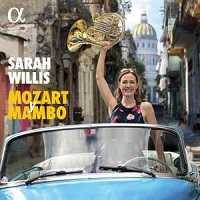 Mozart y Mambo
Mozart y Mambo
Wolfgang Amadeus MOZART (1756-1791)
Concerto Movement for Horn in E-flat, K.370b (1781) [5:02]
Dámaso PÉREZ PRADO (1916-1989)
Qué Rico el Mambo
(1949-50) (arr. Joshua Davis) [2:35]
Wolfgang Amadeus MOZART
Rondo in E-flat for Horn and Orchestra, K.371 (1781) [6:25]
Edgar OLIVERO (b. 1985)
Sarahnade Mambo
(based on Mozart’s Eine Kleine Nachtmusik) [6:34]
Wolfgang Amadeus MOZART
Horn Concerto No.3 in E-flat, K.447 (c.1784-87) [14:21]
Joshua
DAVIS, Yuniet LOMBIDA PRIETO
Rondo
alla Mambo
(based on the third movement of Mozart’s Horn Concerto, K.447) [6:03]
Isolina CARRILLO (1907-1996)
Dos Gardenias
(1945) (arr. Jorge Aragón) [5:05]
Moisés SIMONS (1889-1945)
El Manisero
(1930) (arr. Jorge Aragón) [8:33]
Sarah Willis (horn)
Harold Madrigal Frías (trumpet); Yuniet Lombida Prieto (saxophone); Jorge
Aragón (piano)
Havana Lyceum Orchestra/José Antonio Méndez Padrón
Havana Horns
The Sarahbanda
rec. January 2020, Oratorio San Felipe Neri, Havana, Cuba. DDD.
ALPHA 578
[54:45]
For CD purchase details see
review.
Stream from
Naxos Music Library.
There are two quite different ways of looking at this recording. On one
level, it’s a whole lot of fun, a classical horn player letting her hair
down in the company of Cuban performers. The cover shot of Sarah Willis,
horn player with the Berlin Philharmonic, standing up in a perfectly
preserved old American car and waving her horn, with more similar shots
inside the booklet, supports that point of view. Some crossover recordings
just don’t work for me; this one definitely does.
It’s fun, too, to hear the Mozart works performed with a bit of a swing –
not too overdone, except in some of the cadenzas, which is quite
legitimate. And it’s fun to hear Edgar Olivero’s Sarahnade Mambo,
a jazzed-up version of Eine kleine Nachtmusik, a work which far
too often receives an over-reverential performance.
The mambo arrangement by Joshua Davis and Yuniet Lombida Prieto of the
Rondo from K447 is also very entertaining while showing love for the
original, a kind of analogue of Flanders and Swann’s take on Flanders
finding his horn ‘gorn’ to the tune of the rondo from Horn Concerto No.4,
K495.
Perhaps best of all, some of the proceeds of the recording go to supporting
young Cuban musicians and providing them with decent sets of instruments.
I’m sure they will treasure them as much as they have treasured their
vintage automobiles.
The other way of summing up the recording is to view it as a missed
opportunity. Sarah Willis’s performance of the Mozart solos is good enough
to make me want to hear a complete recording from her of all his extant
works for horn. I know that there are many such collections, on modern
instruments and period-aware, and that some of these have stood the test of
time, such as Barry Tuckwell with the ECO in1983 (Decca E4586072, download
only), or even earlier with the ECO and Peter Maag (Decca Originals
4782659). Inexplicably, the two most recent incarnations of the Denis
Brain/Herbert von Karajan recording are download only and, at over £11 for
lossless, with no booklet, more expensive than when they were on CD.
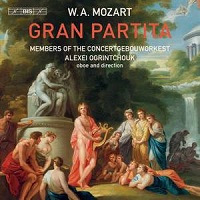 Wolfgang Amadeus MOZART (1756—91)
Wolfgang Amadeus MOZART (1756—91)
Serenade in B-flat, ‘Gran Partita’, K361/370a [47:51]
Ludwig van BEETHOVEN (1770—1827)
Eight Variations on ‘Là ci darem la mano’ from Mozart’s Don Giovanni, WoO28 [9:24]
Members of the Concertgebouworkest/Alexei Ogrintchouk (oboe)
rec. March/April 2019, Kleine Zaal of the Concertgebouw, Amsterdam. DDD/DSD
Reviewed as 24/96 download with pdf booklet from
eclassical.com
BIS-2463-SACD
[58:07]
Stream from
Naxos Music Library.
Like Ralph Moore – Recommended:
review
– this wouldn’t be my only choice for this wonderful music, but it
certainly comes with a strong recommendation.
RM’s reservation about playing time is covered by eclassical.com’s
per-second charging policy for their downloads; for a short time, too,
their 24-bit versions, including surround sound, come at the same price as
16-bit.
A Divine Art recording of the Gran Partita adds Serenade No.11,
featuring a
correction to the score, to make a much longer recording –
review. That, too, can be downloaded from
eclassical.com
in 16- and 24-bit sound, with pdf booklet. In
December 2016, I wrote ‘Unless you must have a period-instrument performance, in which
case the Decca Duo [Amadeus Winds,
4580962, download only] offers a very good bargain, this new Divine Art CD is a
very good way to obtain two works which raised the serenade well above
other examples of the genre’.
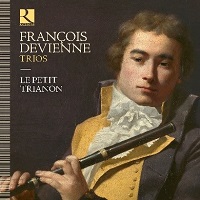 François DEVIENNE (1759-1803)
François DEVIENNE (1759-1803)
Trio for transverse flute, violin and cello in g minor, Op.66/2 [15:43]
Trio for bassoon, violin and cello in F, Op.17/4 [13:34]
Trio for transverse flute, violin and cello in C, Op.66/3 [18:35]
Trio for bassoon, violin and cello in E flat, Op.17/5 [8:35]
Trio for transverse flute, violin and cello in D, Op 66/1 [15:06]
Le Petit Trianon
rec. June 2019, Église Notre-Dame, Centeilles, France. DDD.
Reviewed as 16/44 press preview
RICERCAR RIC416
[71:31]
For CD purchase details please see review by
Johan van Veen,
‘delightful music [in] engaging and differentiated performances
[reflecting a] thoughtful approach to the repertoire and the wishes of the
composer’.
Stream from
Naxos Music Library.
Devienne is your man for attractive flute music – there he is on the CD
cover with the instrument. A good introduction to his music for the
instrument would be via the recordings of his flute concertos made by
Patrick Gallois and the Swedish Chamber Orchestra for Naxos, not quite as
many as you might think from the label ‘Volume 13’ given by some dealers to
Volume 4, which opens with his Concerto No.13 (8.573697).
Reviewing that volume,
I wrote that ‘this final volume of the series [is] an ideal introduction
to Devienne’s flute concertos. Lovers of eighteenth-century music should
aim to have at least one of the series’. That applies equally to
this Ricercar recording.
You might be forgiven for thinking that 72 minutes of music for flute,
violin and cello in major keys would be too unvaried, but that’s not the
case. Not only does the bassoon replace the flute in some of the trios,
there’s variety within the music and the performances.
For another recording of attractive, if inconsequential, flute music from
the eighteenth century, try the recent Somm Hoffmeister’s Magic Flute –
review.
Look out, too, for my
review
of Music for a Viennese Salon, music by Kraus, Dittersdorf and an
arrangement for flute and strings of Haydn’s Symphony No.94 (AVIE AV2423).
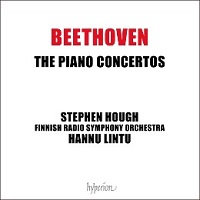 Recording of the Year
Recording of the Year
Ludwig van BEETHOVEN (1770-1827)
Piano Concertos Nos. 1-5
Stephen Hough (piano)
Finnish Radio Symphony Orchestra/Hannu Lintu
rec. June 2019
Reviewed as 24/96 download with pdf booklet from
hyperion-records.co.uk.
HYPERION CDA68291/3
[172:13]
For CD purchase and other details –
review
–
review
–
review.
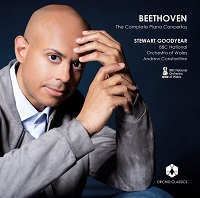 Recording of the Year
Recording of the Year
Ludwig van BEETHOVEN
Piano Concertos Nos. 1-5
Stewart Goodyear (piano)
BBC National Orchestra of Wales/Andrew Constantine
rec. 2018
ORCHID CLASSICS ORC100127
[3 CDs - 2:52:44]
For CD purchase details see
review.
Stream from
Naxos Music Library.
Among the many fine Beethoven recordings which have been released
in this
anniversary year, these sets from Hyperion and Orchid Classics were each
nominated by two MusicWeb reviewers as Recordings of the Year. It’s no surprise that the independent labels have led the
way again this year, with Hyperion receiving more nominations than any
other. Among the major
labels, DG offered vintage performances of these concertos, with various
soloists, and a newly-recorded complete set with Jan Lisiecki as soloist –
see
Spring 2020/1A
for these and other Beethoven releases and reissues. Alpha have also
brought us some fine single-CD recordings from Martin Helmchen, Deutsches
Symphonie-Orchester Berlin and Andrew Manze:
- 1 and 4 ALPHA575 –
review
- 2 and 5 ALPHA555 –
review
–
Spring 2020/1A
- 3 and Triple Concerto ALPHA642 [with Marie-Elisabeth
Hecker (cello) and Antje Weithaas (violin)] –
review
and see below.
but these two complete sets lead the field.
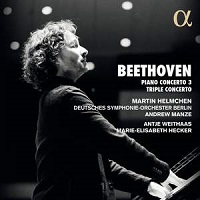 Ludwig van BEETHOVEN (1770-1827)
Ludwig van BEETHOVEN (1770-1827)
Piano Concerto No.3, Op.37 [34:25]
Triple Concerto, Op.56 [35:25]
Martin Helmchen (piano)
Antje Weithaas (violin)
Marie-Elisabeth Hecker (cello)
Deutsches Symphonie-Orchester Berlin/Andrew Manze
rec. Berlin Philharmonie, Feb 2020 and Teldex Studio, Berlin, Sep 2019.
DDD.
Reviewed as lossless (wav) download
ALPHA 642
[70:02]
For CD purchase details see
review.
Stream from
Naxos Music Library.
If Beethoven 250 Year had not given us such very fine recordings of his
complete piano concertos as the two listed above, I think we might have
been hailing the Helmchen – Manze partnership, completed with this
recording, as one of its highlights. For me, this final part of the series
is in many ways its crowning glory, with a version of Concerto No.3 to
rival the very best, including the classic from Annie Fischer and Ferenc
Fricsay, which was my introduction to the work. (In the DG 250 set of
Historical Recordings, 4837666, download only). Similarly, the Triple
Concerto, while not ousting my benchmark from Schneiderhahn, Anda, Fournier
and Fricsay (DG Originals 4775341, with Brahms), certainly challenges it,
and in better sound.
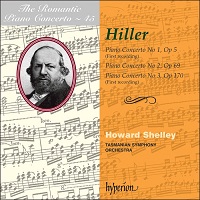 The Romantic Piano Concerto 45 - Ferdinand HILLER (1811-1885)
The Romantic Piano Concerto 45 - Ferdinand HILLER (1811-1885)
Piano Concertos Nos. 1 in f minor, Op.5, 2 in f# minor, Op.69, and 3 in
A-flat ‘Concerto espressivo’
Tasmanian Symphony Orchestra, Howard Shelley (piano)
rec. May 2007. DDD.
Reviewed as lossless download with pdf booklet from
hyperion-records.co.uk.
HYPERION CDA67655
[76:17]
I originally
reviewed
this, many moons ago, in m4a, at 256 kb/s, which must have been derived
from iTunes. Listening to it again reveals all the inherent imperfections
of mp3 and m4a, especially when delivered at less than the maximum 320
kb/s; the piano tone in particular sounds rather tinny – I must have been
listening originally with my cloth ears. As downloaded in lossless sound
from Hyperion, the tinniness disappears. What remains, of course, is the
strong case which the performances make for Hiller’s music – far superior
to the Vox recordings of this repertoire that we used to make do with.
I’m surprised to see Hyperion, who have a well-deserved reputation for
quality, still offering this and other recordings to ‘download on iTunes’.
At £8, Hyperion’s own superior download costs £0.01 more than the iTunes
version.
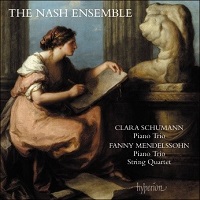 Recording of the Year
Recording of the Year
Clara SCHUMANN (1819-1896)
Piano Trio in g minor Op.17 (1846) [24:35]
Fanny MENDELSSOHN (1805-1847)
Piano Trio in d minor Op.11 (1847) [24:35]
String Quartet in E flat (1834) [18:51]
The Nash Ensemble
rec. 2019, S. Silas the Martyr, Kentish Town, London
Reviewed as 24/96 download with pdf booklet from
hyperion-records.co.uk
HYPERION CDA68307
[71:49]
For CD purchase details see
review
It’s excellent that Clara Schumann is finally receiving her due, whether
with Fanny Mendelssohn, as here, or with Robert on a recent CD of music for
violin and piano (Naxos 8.579067). She has only a walk-on part there,
whereas here she shares the programme more evenly with Fanny Mendelssohn,
who is also finally being properly recognised. Writing about the Naxos –
review
– I mentioned the parallel case of Elizabeth Browning, whose poetry has a
claim to be considered the equal of her husband’s.
Hyperion have given us the two piano trios before, from the Dartington
Quartet (CDH55078): fine performances, but the new Nash Ensemble recording
has the edge, not least by giving us extra music.
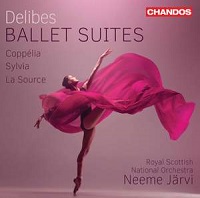 Léo DELIBES (1836–1891)
Léo DELIBES (1836–1891)
Ballet Suites compiled by Neeme Järvi
Suite from Sylvia, ou La Nymphe de Diane (Sylvia, or the Nymph of
Diana) Ballet in three acts (1876)1 [23:48]
Suite from La Source, ou Naïla (The Spring, or Naïla) Ballet in
three acts and four tableaux (1866) [28:38]
Suite from Coppélia, ou La Fille aux yeux d’émail (Coppélia, or
the Girl with Enamel Eyes) ballet in three acts (1870) 2 [30:28]
Sharon Roffman (violin)1
Josef Pacewicz (clarinet)2
Royal Scottish National Orchestra/Neeme Järvi
rec. Royal Concert Hall, Glasgow, 4 and 5 November 2019. DDD/DSD
Reviewed as 24/96 press preview
CHANDOS CHSA5257 SACD
[82:55]
For SACD purchase see
review
–
review.
Stream from
Naxos Music Library.
Suites from the Delibes ballets take us back to the sort of offering more
common on LP than in the CD era, except that you would never have got 83
minutes on one LP, even in the latter days of direct metal mastering. Nor
would you have got this particular selection, made by Neeme Järvi, or this
quality of recording – excellent in 24-bit sound, once I had turned the
volume up. That’s something that has been not uncommon on recent Chandos
releases, but, with the music in high-def sound on SACD or in the 24-bit
which I received, there’s no risk of distortion in turning up the wick. No
other recording of this music is available on SACD or in 24-bit sound.
Two of the suites follow the order of the music in the complete ballet, but
the music from la Source, for which Delibes was only joint contributor, doesn’t.
I’ve concentrated on Coppélia because it’s the best-known music
here; get that right, as Järvi very largely does, and all else falls into
place. Järvi’s affection for the music is very clear from the performances,
and the RSNO give him all the support that the music needs.
Järvi’s Suite from Coppélia is twice as long as that
recorded by Herbert von Karajan with the Berlin Philharmonic in 1961.
That would be a good recording to choose for comparison, except that
it’s more expensive as a download-only offering than when it was a
budget CD (DG Resonance 4296312, with Les Sylphides Suite and Offenbach Gaité Parisienne, download only).
An even shorter selection is included on a recording from Sir Charles
Mackerras (Warner Parlophone Encore 5752212, with Sylvia –
excerpts and Messager Les deux pigeons – Suite). That used to be
at budget price on CD, but, once again, its appeal is much reduced at more
than the usual full price as a download only, but it’s well worth streaming
from
Naxos Music Library.
Ansermet with the Orchestre de la Suisse Romande (1961) offered a suite
comparable with that chosen by Järvi, but the Decca Eloquence reissue
(4800083, with Ravel Daphnis et Chloë Suite No.2) seems to have
disappeared in all formats.
There’s no doubt, then, that the new Chandos recording fills an important
gap for those who want something more than a few items from each of these
ballets but less than the complete recordings from the likes of Richard
Bonynge (2-for-1 Double Decca 4448362: Coppélia with Massenet Le Carillon) or even a substantial full-CD selection such as Mark
Ermler’s with the Covent Garden Orchestra (Sony 88697574732, download
only). In fact, there’s a lot to be said for the 74-minute Ermler
recording, with all the important music from the ballet, but, at £11.99 or
more, without booklet - an all-too-common problem - most of the download
providers are asking too much. It contains everything that Järvi includes
and more, but in every other respect the new recording is its equal – and
in superb sound, and with first-rate notes. Altogether very enjoyable.
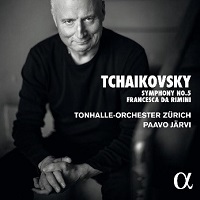 Pyot’r Ilyich TCHAIKOVSKY (1840-1893)
Pyot’r Ilyich TCHAIKOVSKY (1840-1893)
Symphony No.5 in e minor, Op.64 (1888) [47:02]
Francesca da Rimini, fantasy for orchestra, Op.32 (1876) [27:02]
Tonhalle-Orchester Zürich/Paavo Järvi
rec. October 2019 (Francesca da Rimini) & January 2020 (Symphony No.5),
Maag Halle, Zurich
Reviewed as lossless (wav) press preview
ALPHA 659
[73:58]
For CD purchase details see
review. Stream from
Naxos Music Library
It would take a superhuman effort to come near, let alone dislodge my
benchmark recording for this symphony: Evgeny Mravinsky with the Leningrad
Philharmonic on DG Originals has it all – Russian fire, the sound of a
Russian orchestra before it became homogenised and budget price – all
except for recording quality, and even that’s pretty good for 1960 stereo
(Symphonies Nos. 4-6, 4775911 –
April 2010).
That’s less than £8 on two CDs, so why it costs almost £24 as a lossless
download from the same supplier is one of those great unsolved mysteries.
Ditto, why one dealer is asking £35.60 for the CDs.
Järvi doesn’t operate at anything like the white-hot intensity of Mravinsky
or Maris Jansons (Chandos CHAN8351 or complete Symphonies, including Manfred, CHAN8672 or 10392, 6 CDs). His calmer, more measured
approach means that the music never gets out of hand, but Mravinsky and
Jansons don’t, either, taking it to the edge of hysteria but never beyond.
So, however good the coupling, the recording stands or falls by the
symphony, and the Järvi doesn’t do it for me, as it does for William
Hedley, except at moments such as the climax of the second movement. I’ll
save this for when I want to hear a cooler-headed Tchaikovsky, but I’m not
sure how often that will be.
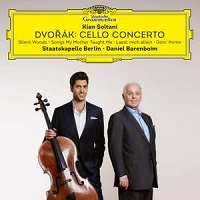 Antonín DVOŘÁK (1841-1904)
Antonín DVOŘÁK (1841-1904)
Cello Concerto
in b minor, Op.104 (B191) (1894/95)1 [41:04]
Four Songs, Op.82/1, ‘Leave Me Alone’ (arr. Kian Soltani)2
[4:25]
Symphony No.9 in e minor, Op.95 ‘From the New World’: IV. Largo.
‘Goin’ Home’ (arr. Stephan Koncz)2 [5:31]
Songs My Mother Taught Me, Op.55/4 (arr. Kian Soltani)2 [2:31]
Romantic piece, Op.75/1 (arr. Kian Soltani)2 [2:56]
Waldesruhe
(Silent Woods) for cello and orchestra, Op.68/5 (arr. Lothar Neifind and
Gunthar Riebke)2 [5:58]
Kian Soltani (cello)1,2
Staatskapelle Berlin/Daniel Barenboim1
rec. live, Berlin Philharmonie, 9 October 20181 DDD.
Staatskapelle Berlin Cellists2
rec. Siemens Villa, Berlin, 7 January 20202 DDD.
Reviewed from CD and as streamed in 24/96 sound.
DEUTSCHE GRAMMOPHON 4836090
[62:28]
CD from
Amazon UK
–
Presto.
Stream from
Naxos Music Library.
Can it really be more than half a lifetime ago – his and mine – since
Daniel Barenboim recorded the Dvořák Cello Concerto with Jacqueline du Pré
and the Chicago Symphony Orchestra? It can and it is. That recording can
still be found on Warner Classics 9029577507 at mid-price, coupled with Waldesruhe, a short album by modern standards, but the price
compensates, and the new DG recording is not vastly longer. There’s an
alternative, download only, release of the Warner; the coupling is the
Haydn Cello Concerto in C, with the English Chamber Orchestra, one of the
first recordings of that then recently-discovered work.
Trevor Harvey, in January 1972 – yes, it was that long ago – didn’t think
either du Pré or Barenboim really attuned to the Dvořák Cello Concerto; it
didn’t become the instant classic that her recording of the Elgar Cello
Concerto, with Sir John Barbirolli, had. Even on CD, the sound is not
ideal, either, with the cello too far forward.
Two recordings stand out because of their couplings: Steven Isserlis with
the Mahler Chamber Orchestra and Daniel Harding, with the composer’s
youthful First Cello Concerto (Hyperion CDA67917 –
DL News 2013/14), and Gautier Capuçon with the Frankfurt Radio Symphony Orchestra and
Paavo Järvi, where the coupling is the Victor Herbert Cello Concerto which
inspired Dvořák while he was in America (Virgin, now Erato 5190352 –
DL News 2012/24).
There’s another recording that I took into account. In my
Spring 2020/3 Short Reviews,
I made a 1961 recording by Pierre Fournier, the Berlin Philharmonic and
George Szell, a Recommended reissue. That’s coupled with the Schumann Cello
Concerto from Mstislav Rostropvich, the Leningrad Philharmonic and Gennady
Rozhdestvensky, also recorded in 1961, on Beulah 1PS66.
My main benchmark, however, had to be Rostropovich with the Berlin
Philharmonic and Herbert von Karajan, coupled more substantially than the
new DG with Tchaikovsky’s Rococo Variations, and available at
mid-price (DG Originals 4474132, around £8.50 on CD, £6.50 as lossless
download). There’s even a vinyl edition, for twice the price: 4797726.
Rostropovich, who had recorded the work many times before, notably in 1952
with Vaclav Talich and the Czech Philharmonic (Beulah 1PDR21, with Walton
and Haydn Cello Concertos –
DL News 2016/1), gives the all-important second movement adagio time to breathe,
and that raises his performance above the competition. If you can tolerate
the mono Supraphon sound, which Beulah have done much to mitigate, his
recording with Talich gives this movement even slightly longer. Even
Fournier sounds a trifle hurried by comparison.
Soltani is now the rising star that Du Pré was back then, but he doesn’t
display the same youthful passion that she did, or it’s restrained by
Barenboim, probably the latter: his live recording of the Dvořák Piano Trio
No.3, with Renaud Capuçon and Lahav Shani seems to have been much more
unbuttoned (Erato 9029552541, with Tchaikovsky). Despite my reservations, I enjoyed hearing
this account of the Dvořák concerto and Silent Woods, though I
could have done without the rather slurpy arrangement of the New World Symphony adagio.
The recording, as heard from the CD, is very good. I also sampled the 24/96
streamed version, which is noticeably more defined, but it comes at a
considerable price – over £19.

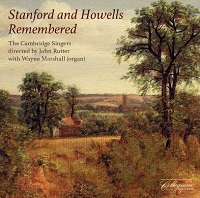 Stanford and Howells Remembered
Stanford and Howells Remembered
Sir Charles Villiers STANFORD (1852-1924)
Evening Service (Magnificat and Nunc dimittis) in G,
Op.81 [7:35
When Mary thro’ the garden went [3:27]
I heard a voice from heaven [4:53]
Magnificat
in B-flat for double choir, Op.164 [11:10]
Magnificat
and Nunc Dimittis in B-flat, Op.10 [6:36]
Six Hymns, Op.113: No.6b, O for a Closer Walk with God [3:17]
Morning, Evening and Communion Services in C Op.115: No. 1, Te Deum [7:23]
Herbert HOWELLS (1892-1983)
Requiem
[17:25]
Magnificat
and Nunc dimittis (Gloucester, 1946) [10:40]
The fear of the Lord [5:18]
Like as the Hart [5:27]
Long, Long Ago [4:42]
All my hope on God is founded [3:17]
Wayne Marshall (organ),
Caroline Ashton, Karen Kerslake, Donna Deam (soprano), Frances Jellard
(alto), Andrew Gant (tenor), Simon Davies, Charles Pott (baritone)
Cambridge Singers/John Rutter
rec. Ely Cathedral and Ely Cathedral Lady Chapel, February 1992. DDD.
Texts and translations included.
Reviewed as lossless (flac) download from
hyperion-records.co.uk.
COLLEGIUM CSCD524
[45:10 + 48:01] For CD details and purchase links, please see reviews by
John
Quinn and
Gwyn Parry-Jones.
Stream from
Naxos Music Library
A shorter version of these recordings was first released on COLCD118 in
1992. It was warmly welcomed, so I’m not sure why it dropped out of the
catalogue, but here it is again, and very welcome, with almost 20 minutes
of extra music, set down at the same time by the BBC Transcription Unit,
but never before issued. On two CDs, the new 93-minute collection sells for
around £9, and the Hyperion download costs £7.99 – beware: others are
charging more for the download, as much as £18.49 for mp3 and £19.17 for
lossless!
The pairing of Stanford and Howells is almost self-selecting; the older
composer referred to the younger, his student at the RCM, where he went on
to tutor others, as his ‘son in music’, and bequeathed him a signet ring
which he wore ever after.
Since 1992, we have had some very fine recordings of the music of both
composers, but the reissue is no less welcome, especially at the attractive
price. There isn’t much point in making detailed comparisons;
this reissue is as self-recommending as the pairing of these composers is
self-evident. The selection plays to the different qualities of both
composers, and the performances serve both composers well.
One item, Howells’ The Fear of the Lord, was actually composed for
John Rutter and his choir at Clare in 1976. It makes a fitting and rousing
conclusion to CD2, but it also exists in a version with fanfare, subtitled
‘Michael’, as on the excellent recent David Hill recording of Missa Sabrinensis (Hyperion CDA68294 –
review
–
review
– Recommended
review).
The acoustic of Ely Cathedral – the main body for the organ, the Lady
Chapel for the vocalists – comes over well in the recording. It’s CD or
16-bit only, but I didn’t miss having a high-def version.
If you thought that Stanford was stodgy, try I heard a voice from Heaven (CD1, track 4). With soaring high
notes from soprano Karen Kerslake, it’s as ethereal as Howells’ setting in
his Requiem, though we more usually ascribe that quality to the younger
composer. It’s also as ethereal as anything from the renaissance composers
whose music Stanford admired. There I was, having just listened to a new
recording of the music of John Sheppard from New College Oxford (Linn
CKD632: Media Vita) and thinking that choral music didn’t get any
better than that, or Taverner, Tallis or Byrd – and being made to think
again on hearing this Collegium reissue.
And, while, the next track, the (Latin) eight-part Magnificat,
Op.164, for double choir, could never be mistaken for the work of a
renaissance composer, it’s just as beautiful and as beautifully crafted.
I’ve seen this work described as ‘Bachian’, but Monteverdi and the North
German composers a few generations before Bach also spring to mind.
In 1992 there was one rival recording of the emotionally evocative Howells Requiem (1932), from the Finzi Singers and Paul Spicer, now part
of an attractive 2-for-1 bargain on Chandos 241-34 (download only, but
available for as little as £6.82 in lossless sound). It’s not a setting of
the Latin Requiem, but a selection of texts from the Book of
Common Prayer and the Psalms appointed for funeral services. As well as the
Chandos, we have had other recordings. One of the most recent comes from
Trinity College,
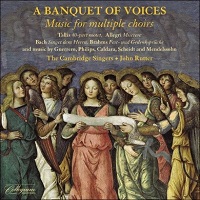 Cambridge, and Paul Layton on Hyperion CDA67914. John
Quinn made that a Recording of the Month –
review
– again recorded in the Lady Chapel at Ely. As I wrote in
April 2012,
choice of coupling might well lead you to that Hyperion recording – but
you may be equally contented with this less expensive and more generously
filled Collegium reissue.
Cambridge, and Paul Layton on Hyperion CDA67914. John
Quinn made that a Recording of the Month –
review
– again recorded in the Lady Chapel at Ely. As I wrote in
April 2012,
choice of coupling might well lead you to that Hyperion recording – but
you may be equally contented with this less expensive and more generously
filled Collegium reissue.
The notes are rather skimpy, but the texts and translations are
included. With more on offer than when it was first released, this
reissue is well worth its modest price – especially in the inexpensive
download from Hyperion. Others charge more. Stanford or Howells? You can
have both here.
Another Collegium reissue restores A Banquet of Voices on CSCD525,
an album of music for multiple choirs from 1993, of which John Rutter
writes, ‘I realize I should never have withdrawn it from the Collegium
catalogue—and all because of an obscure musicological question in my mind
over a Gregorian chant, long since resolved’. That, too, can be downloaded
from
hyperion-records.co.uk. Stream from
Naxos Music Library
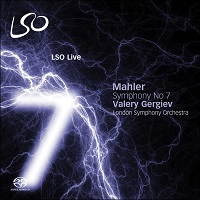 Gustav MAHLER (1860-1911)
Gustav MAHLER (1860-1911)
Symphony No.7 in e minor ‘Song of the Night’ [71:55]
London Symphony Orchestra/Valéry Gergiev
Revisited as 24/96 download with pdf booklet from
hyperion-records.co.uk.
rec. March 2008, Barbican, London. DDD/DSD
LSO LIVE LSO0665 SACD
[71:55] Stream complete set from
Naxos Music Library
This is another recording which I originally
reviewed
in mp3. I thought the sound more than acceptable, but was less happy with
the mp3 No.6, which I reviewed at the same time. Nor did the download from
emusic.com (no longer available) come with the booklet. The Hyperion
download remedies both problems: much improved 24-bit sound and the booklet
is included. No.6 didn’t supersede Szell (Sony), but I was impressed – and
remain impressed – by Gergiev’s No.7. It’s inexpensive, too – £6.50 in
16-bit, £9.75 in 24-bit – but the SACD is less expensive still – around £5.

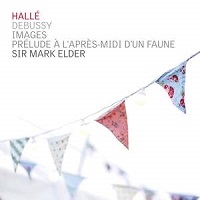 Claude DEBUSSY (1862-1918)
Claude DEBUSSY (1862-1918)
Images
for orchestra, L122 (1905-1912) [37:29]
Et la lune descend sur le temple qui fut
(Images pour piano - Book 2/II, L120, orch. Colin MATTHEWS, world premiere recording) (1907) [6:14]
La plus que lente, L128 (1910) [5:57]
Prélude à l’après-midi d’un faune, L87* (1894) [10:40]
Katherine Baker (flute)*
Hallé Orchestra/Mark Elder
rec. 10-11 May 2019, BBC Studio HQ7, Salford and 1 August 2018, Bridgewater
Hall, Manchester. DDD.
Reviewed as 24/44.1 download with pdf booklet from
hyperion-records.co.uk.
HALLÉ CDHLL7554
[60:42]
For CD purchase details see
review.
For any music lover of a certain age, Debussy’s music, especially the
orchestral Images and Prélude à l’après-midi d’un faune,
comes with a good deal of historical paraphernalia in the form of memories
of recordings which shaped our appreciation of the music. Haitink, Ansermet,
Munch, Monteux, Baudo, and, more recently, Rattle and Dutoit, all feature
in my list.
Bernard Haitink’s 2-for-one album brings together Images and Faune with much other valuable Debussy on Decca Duo 4387422, well
worth grabbing because these Universal twofers have been disappearing
recently, sometimes completely, sometimes as downloads costing more than
the CDs. The same applies to Charles Dutoit’s recordings on a Double Decca,
another 2-for-1 album, offering a similarly fine introductory collection of
Debussy’s music (E4602172).
With the new Hallé release, I’m back where I was in reviewing their
recording of the Debussy Nocturnes and other music, again on the
orchestra’s in-house label, a few months ago –
Winter 2019/20 #3.
In brief, both recordings add to my appreciation of Sir Mark Elder as a
complete Debussy interpreter; both contain first recordings of Colin
Matthews’ first-rate orchestrations of the piano music, and are available
not only on CD but in better-than-CD 24-bit downloads from Hyperion for £9,
less than the cost of the CD and less than others charge for CD-quality
16-bit. The latter comes at just £7.99 from Hyperion.
By chance, I listened to this recording on an afternoon when it was too hot
to think much. Not only did that make the music ideal for the occasion,
opening with the orchestral Images and closing with the faun’s
lazy/erotic afternoon, it meant that it didn’t take a lot of brain power to
like what I heard and to rate it, like that earlier release, up there with
Haitink et al, but not necessarily replacing them.
I’d forgotten just how much of a problem child the orchestral Images were for Debussy; the booklet reminds us that he wrestled
with the music for seven years, but the best recordings give no hint of the
difficulties, and nor does the new Hallé account. Pierre Monteux recorded
only the first two Nocturnes with the LSO (Decca Eloquence
4806567), though he included Sirènes on his San Francisco
recording for RCA – but he never seems to have had any problem in recording
the whole Images in 1963.
Christopher Howell,
reviewing
an earlier incarnation of the Monteux, thought the LSO’s playing for
Monteux less than ideal, but their association with Monteux and Previn in
the 1960s was a high point in their history, and I rather think that if
they ‘hang fire’ at times, that’s the way that Monteux wanted it. CH gives
us relative timings for Monteux and Munch (RCA), whereby it appears that
the former was feeling all of his 88 years, but my thoughts are more in
line with those of Jonathan Swain who, considering all the then available
versions in Gramophone in 1996, placed Monteux, though available then only
on a 7-CD set, ahead even of Haitink and Rattle.
Elder gives us even more expansive accounts than Monteux of all three Images. Expansive, but by no means dull or lacking in energy. At
8:19, Gigues looks on paper as if it might drag, but a slower
speed than usual is quite appropriate; after all, Debussy originally
intended to call it Gigues tristes. Its ‘now it’s there, now it
isn’t’ semi-quotation of the Northumbrian song Weel may the keel row, not exactly the liveliest of tunes, acting
as a pendant to a haunting tune on the oboe d’amore, is well brought out in
Elder’s interpretation. You would hardly know from the assured performance
that this section was the last of the Images to be completed, and
that Debussy may well have had to call in assistance with the
orchestration.
Nor does Elder unduly hurry the pace in the three sections of Ibéria, here given separate tracks, or in the finale Rondes de printemps. In the latter, once again, the dance is not
one of the most exuberant and, here too, the ambiguity between the title
and the music is fully brought out. This is not the outburst of Spring that
we get from Schumann’s ‘Spring’ Symphony, or Mahler’s First Symphony, or
Debussy's own Printemps.
I’ve been thinking a lot recently about representations of the night in
music, not least in respect of a fine Linn recording of Nights in the Gardens of Spain, from the youthful Orchestra of the
Americas and Carlos Miguel Prieto (CKD625, with Falla Three Cornered Hat). I like their account of In the Gardens of the Generalife in particular; it’s a special
favourite of mine, but I’m not sure that the central section of Ibéria, Les parfums de la nuit, as performed by the
Hallé, doesn’t displace it as my Desert Island choice.
Those Colin Matthews orchestrations that I have heard to date have all been
true to their pianistic originals, while casting them in an even more
attractive light. After all, many of Debussy’s best-known works were
orchestrated by others. This version of Et la lune descend sur le temple qui fut is the first of Matthews’
reworkings of the complete Book II to be recorded; it’s a beautiful piece,
beautifully performed. We’ve had the three Book I orchestrations from
Gustavo Gimeno with the Luxembourg Orchestra (Pentatone PTC5186627). Now
may we have the rest of Book II, please?
The big surprise in La plus que lente is, first, that it’s not the
slowest piece you have ever heard, and, second the striking use of the
cymbalom.
John Wilson, with the revived Sinfonia of London on an anthology of French
music entitled Escales, recently gave us as hot and sultry a
version of Faune as any that I have heard (Chandos CHSA5252:
Recommended –
review
–
review
–
review).
Elder’s interpretation, a minute and a half longer, is more in line with
Haitink’s slower burn. Both interpretations work well – and both suit their
respective programmes, the new Hallé ending the album as languidly as it
began; the Chandos on a recording beginning in livelier mode with Chabrier’s España. In truth, there’s less difference than the timings
suggest; Elder is not too languid – he doesn’t neglect the almost tactile
appeal of the work – and, equally, Wilson is certainly never rushed.
Flautist Katherine Baker’s contribution to the Hallé recording is
deservedly acknowledged.
Wilson’s Chandos recordings have included the return of an old name, the
Sinfonia of London, and they have been giving him splendid support of a
quality to match their finest hour when they recorded Elgar for Sir John
Barbirolli. Barbirolli, of course, though he conducted other orchestras,
was best known for his work with the Hallé. I think he would be well
pleased with the support which they give to Sir Mark Elder on this and
other recent recordings. Warner have recently reissued all Sir John’s
recordings from the EMI and Pye catalogues – well worth considering, though
you’ll need another garden shed to house the 109 CDs, and there’s no
download equivalent, though some individual albums have been released in
that form. I can well believe that someone will be reissuing an equally
desirable Elder collection half a century from now.
The recording, especially as heard in 24-bit, is excellent, chiefly in that
it doesn’t call attention to itself. You may find that a small volume boost
brings even more presence. The booklet is very informative.
Individually, these pieces may not replace my old favourites, but the
inclusion of the Matthews orchestration clinches my decision to make this a
Recommended recording. A splendid continuation of the Debussy recordings
which the Hallé and Elder have been giving us since their La Mer
and the orchestrated Préludes caught John Quinn’s attention in
2007 (CDHLL7513:
Recording of the Month).
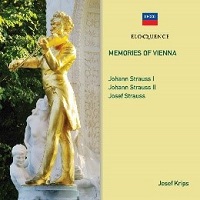 Recording of the Year
Recording of the Year
STRAUSS Family
Memories of Vienna
Hilde Gueden (soprano)
London Symphony Orchestra, New Symphony Orchestra, Wiener
Philharmoniker/Josef Krips
rec. 1948-57
DECCA ELOQUENCE 4840692
[76:01]
For CD purchase details see
review.
I slipped in a recommendation to this recording in reviewing the 2020 New
Year’s Concert from Vienna: ‘If you needed a reminder of Krips as a fine
conductor, this could be it’. Willi Boskovsky’s Strauss would still top my
vintage recommendations, but Krips would not be at all far behind.
 Recording of the Year
Recording of the Year
Jean SIBELIUS (1865-1957)
Symphony No.2
in D, Op.43 (1901-02) [45:29]
King Christian II (Suite), Op. 27 [25:10]
Gothenburg Symphony Orchestra/Santu-Matias Rouvali
rec. 2019, Gothenburg Symphony Hall, Sweden
ALPHA CLASSICS 574
[70:43]
For CD purchase details see
review.
Stream from
Naxos Music Library
I was one of the first to appreciate Santu-Matias Rouvali’s recording of
the Sibelius Symphony No.1 –
review.
If I seemed a little less enthusiastic about No.2, that’s merely because
there have been some outstanding recordings of this symphony, many of them
now rightly regarded as classics, from Beecham (a super-budget download
from Past Classics in acceptable sound), Collins (Eloquence 4429490,
download only –
review)
and Sibelius’s friend Hannikainen (Magdalen METCD8024 –
review), the latter marred only by an unintentional cut which he tried to pass
off as the composer’s revision, and more recently by Vänskä, his Lahti
version preferable to the Minnesota remake (both BIS, singly or as a set).
All that said, the Rouvali Second is well worth having, especially if the
coupling appeals.
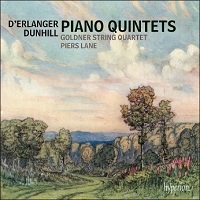 Recording of the Year
Recording of the Year
Frédéric d’ERLANGER (1868-1943)
Piano Quintet (1901) [37:49]
Thomas DUNHILL (1877-1946)
Piano Quintet in c minor, Op.20 (1904) [35:25]
Goldner String Quartet
Piers Lane (piano)
rec. 2019, Potton Hall, Dunwich, UK
Reviewed as 24/96 download with pdf booklet from
hyperion-records.co.uk
HYPERION CDA68296
[73:14]
For CD purchase details see
review
As so often, Hyperion place us in their debt with a recording of chamber
music by two neglected composers. Neither is currently otherwise available,
and I don’t recall any other recordings of either, though Hyperion have
already brought us Erlanger’s Violin Concerto in d minor, Op.17, and Poeme in D (CDA67838, with Cliffe Violin Concerto in d minor –
review
–
DL Roundup March 2011/2).
Recording of the Year
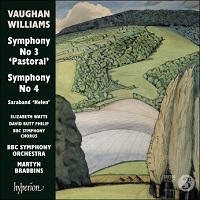 Ralph VAUGHAN WILLIAMS (1872-1958)
Ralph VAUGHAN WILLIAMS (1872-1958)
Symphony No.3 ‘Pastoral’ (1921)1 [37:29]
Symphony No.4 in f minor (1931/34) [34:16]
Saraband ‘Helen’ Was this the face that launched a thousand ships?
(1913/14, unpublished)2 [9:06]
Elizabeth Watts (soprano)1
David Butt Philip (tenor), BBC Symphony Chorus2
BBC Symphony Orchestra/Martyn Brabbins
rec. 26-27 November and 2 December 2018, Watford Colosseum. DDD.
Reviewed as 24/96 download with pdf booklet from
hyperion-records.co.uk.
HYPERION CDA68280
[80:51] For CD purchase details see
review
–
review
–
review
Of the two recent series of the Vaughan Williams symphonies, that conducted
by Andrew Manze (Onyx) has received more attention; it was first in the
field and was completed first. I enjoyed it in the main, but with
reservations which have sometimes been shared by others. What is not in
doubt, however, is the value of the supplementary release of a recording of
shorter pieces, which was so good that I hoped we might have more (ONYX4212
–
review). Simon Thompson also enjoyed that recording –
review;
his one reservation, that the wordless version of the Serenade to Music had been chosen, was, for me, one of the strong
points. Jim Westhead also had few reservations, though he would have
preferred one of the VW rarities to the oft-performed Greensleeves
Fantasia –
review.
Now Hyperion continue their equally impressive series. This account of two
contrasting symphonies, and the first performance of a work that was never
published, brings their tally to Nos. 1-4, having previously given us No.1, the ‘Sea Symphony’ (CDA68245 –
review
–
review
–
review
–
Autumn 2018/2)
and No.2, the ‘London Symphony’ and shorter works (CDA68190 –
review
–
Autumn 2017/1). Their account of the sublime Flos Campi and the Suite for viola
and small orchestra, with Lawrence Power as soloist, is coupled with
McEwen’s Viola Concerto on CDA67839 –
review.
Paul Corfield Godfrey’s choice of this album as one of his Recordings of
the Year reminds me that I never actually completed the review that I
started with the words above – largely because PCG’s
review
said it all, as succinctly summarised with his RoTY choice: ‘The two
symphonies are given superlative performances under Martyn Brabbins, as one
might expect, but the real highlight on this disc is the world première of
the Helen Saraband, a setting of Marlowe hitherto totally unknown
and anticipating the composer’s later developments in quite startling
ways’.
Since then, Hyperion have given us the next instalment in this series:
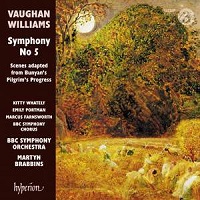 Ralph VAUGHAN WILLIAMS (1872-1958)
Ralph VAUGHAN WILLIAMS (1872-1958)
Symphony No.5 in D (1938-1943) [40:04]
Scenes adapted from Bunyan’s Pilgrim’s Progress (1906)* [26:46]
Emily Portman (folk voice), Kitty Whately (mezzo), Marcus Farnsworth
(baritone)*
BBC Symphony Chorus; BBC Singers Quartet*
BBC Symphony Orchestra/Martyn Brabbins
rec. Watford Colosseum, 2 December 2018* and 4/5 November 2019. DDD.
Texts included
Reviewed as 24/96 download with pdf booklet from
hyperion-records.co.uk.
HYPERION CDA68325
[66:59] For CD purchase details see John Quinn’s
review: ‘It’s a fine [recording]; indeed, I think it may be the highlight to date
of Martyn Brabbins’ cycle’.
I’ve included my thoughts on this latest release in a very fine series
in my article
Hyperion at 40.
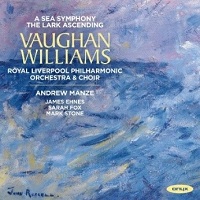 Ralph VAUGHAN WILLIAMS (1872-1958)
Ralph VAUGHAN WILLIAMS (1872-1958)
A Sea Symphony
(1903-09) [62:54]
The Lark Ascending
[14:33]
James Ehnes (violin)
Sarah Fox (soprano); Mark Stone (baritone)
Royal Liverpool Philharmonic Choir
Royal Liverpool Philharmonic Orchestra /Andrew Manze
rec. 2017, Blackheath Concert Halls, London. DDD
Texts included
ONYX 4185
[77:32] For CD purchase details see
review
by John Quinn: ‘[It] doesn’t challenge the best … Boult’s second (EMI)
recording and Sir Mark Elder’s account with the Hallé’.
Stream from
Naxos Music Library
This review is so long overdue that it’s almost archaeology by now. My only
excuse it that John Quinn’s review, as so often, says all that needs to be
said. At the risk of repeating what I have just written above, it’s the
collection of short pieces in this Manze series that really caught my
attention (ONYX4212 –
review).
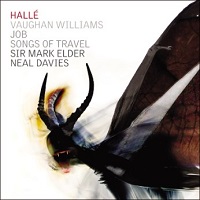 Ralph VAUGHAN WILLIAMS (1872–1958)
Ralph VAUGHAN WILLIAMS (1872–1958)
Songs of Travel
(1901–1904)1
[Orchestrations: The Composer (Nos. I, Iii & Viii) (1905); Roy Douglas
(Nos. Ii, Iv–Vii & Ix) (1962)] [24:07]
Job
A Masque for dancing, founded on William Blake’s Illustrations of the Book
of Job (1927–1930)2 [45:41]
Neal Davies (bass-baritone)1
David Adams (violin)2
Darius Battiwalla (organ)2
Hallé/Sir Mark Elder
rec. 2–4 July 2019, Bridgewater Hall, Manchester. DDD.
Texts included.
Reviewed as 24/44.1 download with pdf booklet from
hyperion-records.co.uk.
HALLÉ CDHLL7556
[70:16] For CD purchase details see
review
by Jim Westhead.
This recording is treading upon hallowed ground. Sir Adrian Boult, the
work’s dedicatee, recorded Job in 1938 on 78s, for Decca with the
LPO in the early days of LP (Naxos Classical Archives 980375, Decca
Eloquence 461222, with The Wasps Suite, both download only), again
in stereo for Everest (EVERCD009, CD and download) and for EMI (Vaughan Williams: The Complete EMI Recordings 9035672, 13 CDs –
review). I’m pleased to have obtained a lossless (flac) transfer of Boult’s EMI Job and 2-piano concerto before it was deleted.
There’s also a fine Beulah transfer of the mono Boult recording, very
interestingly coupled with Rawsthorne’s Street Corner and the
classic David Oistrakh, LSO/Hindemith recording of the Hindemith Violin
Concerto (4PDR20). I recommend obtaining that from
Qobuz
in lossless sound, but, since it runs a few seconds over 80 minutes, they
charge £11.99, rather than their usual £7.99. The alternative is to save £4
and choose the less than ideal mp3 from Amazon UK or iTunes.
Boult alumnus Vernon Handley also made a highly regarded recording of Job: Amazon UK still have a few copies of the Classics for
Pleasure CD on which it’s paired with the Tallis Fantasia and Five Variants of Dives and Lazarus –
review
– but it seems to be on its way out of the catalogue. That’s still my
reference recording, so the apparent demise of this recording – a
well-deserved key and 4-stars from the Penguin Guide – and the fact that
the Boult is incarcerated in a large set are much to be regretted. (NB:
what Amazon UK advertise as the download of the Handley actually seems to
be the mono Boult in a transfer for which I cannot vouch on an anonymous
label.)
The most recent Job, from Sir Andrew Davis and the Bergen
Philharmonic, with Symphony No.9, earned Recording of the Month status in
2017; John Quinn thought it a mandatory purchase for all Vaughan Williams
enthusiasts –
review.
Dave Billinge, listening to the surround sound tracks on that SACD, was
also impressed, though not in preference to Boult, Handley and Lloyd-Jones
(Naxos) –
review.
While remaining faithful to Boult and Handley, I thought the Chandos
irresistible –
Spring 2017/2.
The Chandos is available on SACD and as a 24-bit download. The new Hallé
comes on CD only, but the 24-bit download from Hyperion is very impressive
– 24/44.1 rather than the usual 24/96, but that doesn’t prevent it from
sounding first-rate, especially at a slightly higher volume than usual. The
Chandos, too, benefits from a volume boost to sound really excellent.
There’s no hi-res version of the Handley or either of the Boult recordings,
but the stereo Boult and the Handley still sound very well and the Beulah
transfer of the mono Boult is certainly much more than tolerable.
There are no huge tempo differences among these recordings. Boult tended to be a
little faster in his EMI recording and Handley tends to be closer to the
older Boult timings, occasionally a little broader in tempo. Elder is more
in line with the EMI Boult in most sections and, apart from the
Introduction, a shade faster than Handley. I made a chart of the Boult,
Decca and EMI, Handley and Elder, but I’ll refrain from bothering readers
with it, because the small variations on paper don’t add up to the
proverbial hill of beans in practice. It’s a work that I play often; I
expect to be listening to the Elder as much as the older recordings.
The Songs of Travel are usually recorded in their original format
with piano accompaniment, but the composer arranged three of them in
orchestral guise and his alumnus Roy Douglas completed the set. There’s a
recent Dutton recording featuring Roderick Williams with the Royal Scottish
National Orchestra and Martin Yates, which we seem not to have reviewed and
which I haven’t been able to access. I do, however, have an old cover CD
from the BBC Music Magazine on which Christopher Maltman sings the cycle
with the BBC Symphony Orchestra and Thierry Fischer (BBC MM239); an
attractive version which I have used as my benchmark. Maltman’s Hyperion
recording of the piano version with Roger Vignoles, made around the same
time (CDA67378), is not quite ideal, but he comes into his own in the
company of the orchestra on one of the very few cover CDs that I have ever
kept.
Other things being equal, I do prefer the orchestral versions of these
songs, but the singer needs to be ideal, and that’s why I shall still hold
on to my cover CD. On the new Hallé recording Neal Davies sings well
enough, but falls just short of holding my attention. I’m not sure exactly
why – everything seems to be in place – but Jim Westhead may have put his
finger on the reason in commenting on the excessive use of vibrato in his
review (link above).
One small observation. The Satan of the Book of Job is not a monster to
frighten children in a bedtime story, but a divine being who reports to God
and bandies words with him almost as an equal. The Hallé cover depiction of
something out of Alien is, therefore, less than appropriate.
A very fine account of Job, then, to set alongside Boult and
Handley, but I was a little disappointed by the Songs of Travel.
The recording, in 24-bit, is very good; at £9, it’s very reasonably priced.
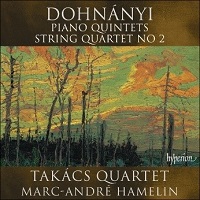 Recording of the Year
Recording of the Year
Ernő DOHNÁNYI
(1877-1960)
Piano Quintet No.1 in c minor Op.1 (1895) [30:43]
String Quartet No.2 in D flat Op.15 (1906) [24:32]
Piano Quintet No.2 in e flat minor Op.26 (1914) [25:43]
Takács Quartet
Marc-André Hamelin (piano)
rec. 2018, Concert Hall, Wyastone Estate, Monmouth, UK
Reviewed as 24/96 download with pdf booklet from
hyperion-records.co.uk
HYPERION CDA68238
[80:58]
Hyperion already had a fine recording of the two quintets, performed by the
Schubert Ensemble of London and available at mid-price on their Helios
label (CDH55412, with Serenade in C for string trio). Like the new
recording, it offers ample playing time (75 minutes) when other
combinations of the quintets or one of the quintets and a quartet are much
less generous. David Barker compared the Helios favourably with a rival,
much shorter (54 minutes), recording on Naxos –
review.
Helios recordings are no longer at budget price, but the Dohnányi can be
found on CD for around £8.50 or downloaded in lossless sound for £7.99 from
Hyperion.
I enjoyed the Helios recording, but thought a download-only Hungaroton
rival only very slightly preferable (HCD11624: Quintet No.2 and Sextet,
Tátrai Quartet –
DL News 2014/10).
If the only music by Dohnányi that you know is the familiar Nursery Variations, these chamber works are very different. That’s
an enjoyable piece which deserves its popularity, and the 5-CD Chandos set
which contains it and several other less-known orchestral works by the
composer, such as the Ruralia Hungarica, is well worth exploring
(CHAN10906(5)X –
review
–
review
–
DL News 2016/8). I took the opportunity to dip into that box of orchestral delights
again, and greatly enjoyed it. That said, the quintets, the quartet and the
Serenade, recorded in various permutations on these albums, are equally
attractive, depending on your preferred coupling.
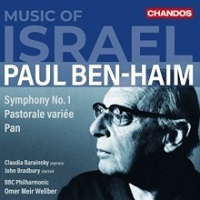 Paul BEN-HAIM (1897–1984)
Paul BEN-HAIM (1897–1984)
Pan, Op.17, A Symphonic Poem for soprano and orchestra (1931, Premiere
recording)1 [15:16]
Pastorale Variée, Op.31b, for solo clarinet with string orchestra and harp (1945, revised
1948)2 [6:57]
Symphony No.1 (1939–40) (Edited by Maestro Lahav Shani) [28:32]
Claudia Barainsky (soprano)1
John Bradbury (clarinet)2
BBC Philharmonic/Omer Meir Wellber
rec. MediaCityUK, Salford, Manchester; 16 December 2019 (Symphony No. 1)
and 4 March 2020 (other works). DDD.
Text and translation included
Reviewed as 24/96 press preview
CHANDOS CHAN20169
[60:45]
For CD purchase details see Recommended
review.
Stream from
Naxos Music Library
Some time ago Chandos included a recording of chamber music by Paul
Ben-Haim in their Musicians in Exile series, which Gary Higginson
found ‘fascinating’ (CHAN10769 –
review). Other labels have also taken up the cause of this unjustly neglected
composer who fled from Nazism and found a new home in Israel. The main work
on the new Chandos recording, the Symphony No.1, has also been recorded by
Israel Yinon with the NDR Philharmonie, Hannover, on CPO (777417-2, withFanfare to Israel and Symphonic Metamorphosis on a Bach Chorale). We seem not to have
reviewed that, though Jim Westfield ‘urgently recommended’ the same
performers’ recording of Symphony No.2 (777677-2 –
review).
I haven’t had a chance to check out the CPO recording, but there’s no
reason to disagree with Stephen Barber’s assessment of the Chandos release
as offering an impressive work in assured performances. Add equally fine
performances of the rest of the programme, including a first recording of Pan, very good
sound quality, as heard in 24-bit, and an excellent set
of notes, and what’s not to like?
 Recording of the Year
Recording of the Year
British Violin Sonatas - Volume 3
York BOWEN (1884-1961)
Violin Sonata in e minor, Op.112 (1945) [20:11]
John IRELAND (1879-1962)
Violin Sonata No. 2 in a minor (1915-17) [25:07]
James Francis BROWN (b. 1969)
The Hart’s Grace (2016) [6:55]
William ALWYN (1905-1985)
Sonatina (1933) [11:16]
Eric COATES (1886-1957)
First Meeting (1941, rev. 1943) [6:35]
Tasmin Little (violin); Piers Lane (piano)
rec. 2019, Potton Hall, Suffolk. DDD.
Reviewed as 24/96 press preview.
CHANDOS CHAN20133
[70:07]
For CD purchase details see
review
–
review.
Stream from
Naxos Music Library
Having reviewed Chandos’ 2-CD parting tribute to Tasmin Little as she
leaves the stage, and thought it a little mean that something chunkier
could not have been on offer, better still a substantial new concert
recording, I must mitigate the complaint, at least partially, in the light
of this third volume in her series of recordings of British Violin Sonatas.
I was going to say that we should be grateful for small mercies, but this
is actually more than ‘small’.
There’s even some breaking of new ground here, in the form of John Francis
Brown’s The Hart’s Grace. His music is as yet not well represented
on record, with just one album completely devoted to it: Prospero’s Isle is a collection of his chamber music (Guild
GMCD7354). William Hedley warmly recommended that ‘beautifully recorded’
disc ‘to any collector interested in the bewilderingly diverse world of
contemporary music’ –
review.
That sounds a little ominous to my stick-in-the-mud ears, but I’m pleased
to report that Heart’s Grace is an attractive work, hardly any
more ‘contemporary’ than the Alwyn. Indeed, had I heard this with an
innocent ear, I might well have thought it the work of any British composer
of the twentieth century, so it sits very well with the rest of the
programme.
Alwyn’s music can sometimes be angular, but it’s never too much to cope
with. His Sonatina opens almost like a piece of Palm Court music,
but soon develops into something more demanding than the diminutive in the
title suggests; this is no lightweight work.
The opening York Bowen sonata is not angular, but it is intense. Though
dubbed a ‘violin sonata’ as shorthand, there’s as much, if not more,
activity from the piano – Bowen’s own instrument, for which he wrote a wide
range of music which has become better known only in recent years. Dating
from 1945, the violin sonata might easily have been composed forty years
earlier, though it’s no worse for that. If you find it attractive – and the
well-established team of Tasmin Little and Piers Lane offers strong
advocacy – the ideal follow-up would be Bowen’s complete music for violin
and piano on Hyperion (CDA67991/2, 2 CDs –
review).
As Michael Wilkinson wrote in his
review
of this new Chandos recording, Little and Lane have nothing to fear from
comparison with that very fine set, or, I would add, from another very fine
collection of British violin sonatas, by Bliss, Bowen and Walford Davies on
EM Records EMRCD001: Recording of the Month –
review
–
review
–
review. The link to classicsonline.com in
DL Roundup July 2011/1
no longer applies, but my award of Promising New Label proved to be very
apt; I’ve since praised several recordings on this label.
For Jonathan Woolf, who chose the new Chandos as one of his Recordings of
the Year, the highlight of the set is the Ireland sonata: ‘I have waited 25
years for [Little] to record John Ireland’s A minor sonata and here it is
at last, the greatest reading of the work since the 78 set of Albert
Sammons and Ireland himself’. I can’t say more than that.
 Recording of the Year
Recording of the Year
Sergei PROKOFIEV (1891—1953)
Symphony No.1 in D, Op.25 (1916—17) (‘Classical’) [13:58]
Symphony No.2 in d minor, Op.40 (1924—25) [36:14]
Symphony No.3 in c minor, Op.44 (1928) [35:19]
Bergen Philharmonic Orchestra/Andrew Litton
rec. May 2015 (No. 1) and August/September 2017 (Nos 2 & 3),
Grieghallen, Bergen, Norway. DDD/DSD
Reviewed as 24/96 stereo download with pdf booklet from
eclassical.com: also available in mp3, 16-bit and 24/96 surround and on SACD.
BIS BIS-2174 SACD
[86:33] For SACD purchase details see
review by Robert Cummings. Stream from
Naxos Music Library.
Can there be a greater contrast between a composer’s first symphony and its
successors, even bearing Beethoven in mind? Between Prokofiev’s ‘Classical’
First and the other two symphonies on this recording, there is a great gulf
fixed. Indeed, if the ‘Classical’ is his most popular and most-recorded
work, it’s not until we come to the Fifth that we find anything approaching
it in popularity. Though Prokofiev apparently thought the Third, based on
music from his opera The Fiery Angel, much rejigged and augmented,
one of his best works, his opinion has not been widely shared.
BIS are certainly doing their bit for Nos. 2 and 3 by getting them onto one
SACD with the First, when rival recordings don’t offer so much for your
money: Jurowski with the Russian State Academy Symphony Orchestra on a
fairly recent Pentatone SACD gives us just 2 and 3 (PTC5186624). Dave
Billinge was not wholly impressed by that recording, which he thought a
little too lacking in danger –
review
– but I decided to use it as a comparator. Like the BIS, I listened to it
in 24/96 format – downloaded in the case of the BIS, streamed in the case
of the Pentatone.
My other inevitable benchmarks, both complete sets of all seven symphonies,
were Neeme Järvi with the RSNO (Chandos CHAN10500X, 4 CDs, around £18:
Bargain of the Month –
review;
the download, paradoxically, is a little dearer) and Valery Gergiev with
the LSO (Philips 4757655, 4 CDs, around £33: Recording of the Month –
review).
My expectations of Litton’s new Prokofiev were not high: both Dan Morgan
and I panned his earlier recording of No.6 and Lieutenant Kije –
DL News 2013/7.
I did expect the ‘Classical’ Symphony, however, to respond well to
Litton’s treatment. It’s a work whose attractions have paled a little since
I was enthralled by it many years ago. Tchaikovsky’s Rococo Variations and works such as Respighi’s Ancient Airs and Dances for the Lute have retained a place in my
affections much more, perhaps because they are based on real earlier music
rather than a synthetic version of it.
Prokofiev’s symphony is palpably an imitation – no ‘classical’ symphony
would ever have sounded like this – and Litton and the Bergen Phil make no
attempt to make it sound other, with full twentieth-century sonority,
though with a perkiness that an early music consort might well envy – try
the larghetto second movement a little before the 2-minute mark.
If anything, his tempo in this movement, slightly faster than Gergiev or
Järvi, makes me inclined to prefer Litton here, and the rest of the
symphony did nothing to change that opinion. Except that Nicolai Malko’s
classic 1955 recording with the Philharmonia remains available as a
Classics for Pleasure download at budget price, and that, with even
sprightlier playing, remains my benchmark. (3822292, with Symphony No.7, Love for Three Oranges Suite and Tchaikovsky Nutcracker
Suite). The sound, from the earliest days of stereo, wears its years more
lightly than this reviewer.
For many years now my go-to CD of the Second Symphony has been from the
French National Orchestra and Mstislav Rostropovich, more for the sake of
the coupling with the Symphony-Concerto from Rostropovich with the LSO and
Seiji Ozawa (Warner Elatus, now available only in a 4-CD set, 2564696755).
That CD had a railway tunnel on the cover, with a burst of light at the end
which might be a ray of sunshine or a train coming the other way.
Rostropovich, assisted by the digital recording, first released by Erato,
pulls no punches, so the idea of a train crash seems apt. He doesn’t make
the music seem lovable, but he does make it seem properly powerful. With an
account of the second movement theme and variations that makes the music
both comforting and unsettling, this is one of the best recordings in this
rather variable complete cycle, so it’s a shame that it’s no longer to be
had singly, though I don’t miss the shabby presentation of the Elatus
version.
Turn to Järvi, however, and the opening movement sounds even more urgent
and brutal, the sound yet more immediate, as heard in lossless flac,
yielding little even to the 24-bit BIS recording. Järvi shaves a whole
minute off Rostropovich’s timing for the movement without ever seeming
about to come off the tracks. Pretty it isn’t, but it is compelling, and
the same is true of Gergiev, who manages even to undercut Järvi by half a
minute. Ben articulato the direction says, and both the RSNO and
the LSO manage to keep their articulation clean and crisp, even at these
speeds.
The Bergen orchestra need fear no competition; their playing, too, is crisp
and well-articulated, as captured in the 24/96 stereo which I was hearing.
The tension from Litton may be at a slightly lower temperature than from
Järvi or Gergiev, but some may prefer it that way. On the whole, however,
the menace which the other conductors maintain is found more intermittently
here, the surface overall slightly smoother, though Litton’s timing for the
movement is only seconds longer than from Järvi – and, by the end of the
movement I was beginning to be caught up more in the tension of the music.
I really do find Prokofiev’s No.3 – and No.4 – hard to come to terms with,
but I can’t argue with Robert Cummings’ view that Litton and the Bergen
Philharmonic are fully committed here. A mixed bag for me; I’m sorry not to
be as enthusiastic as my colleague, for whom it was a Recording of the Year
and a Winner on every count.
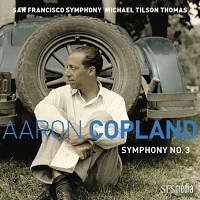 Recording of the Year
Recording of the Year
Aaron COPLAND (1900-1990)
Symphony No. 3 (1944-1946)
San Francisco Symphony/Michael Tilson Thomas
rec. live, 15-17 March 2018, Davies Symphony Hall, San Francisco, USA
Reviewed in 24/192 stereo download from SFS Media Programme notes here
A digital-only release: 16/44.1; 24/96; and 24/192 stereo/multichannel.
DDD/DSD
SFS MEDIA SFS 0078
[42:33]
For purchase links see
review.
For Dan Morgan, this recording now tops the tree, and I find it hard to
disagree, especially as heard in 24/96 sound, streamed from
Qobuz. Definitely not one to economise on by choosing mp3.
 Recording of the Year
Recording of the Year
Dmitri SHOSTAKOVICH (1906-1975)
Violin Concerto
No.1 in a minor, Op.77 (1947/48) [39:01]
Violin Concerto No.2 in c-sharp minor, Op.129 (1967) [32:25]
Alina Ibragimova (violin)
State Academic Symphony Orchestra of Russia ‘Evgeny Svetlanov’/Vladimir
Jurowski
rec. 2019, Museum and Exhibition Complex ‘New Jerusalem’, Moscow (No.1),
Tchaikovsky Concert Hall, Moscow (No.2)
Reviewed as 24/96 download with pdf booklet from
hyperion-records.co.uk.
HYPERION CDA68313
[71:29]
For CD purchase details see
review.
I’m delighted to see that this was selected as a Recording of the Year – it
was one of the runners-up that I mentioned in my choice and it’s included
with the
Hyperion at 40
selection which I reviewed recently.
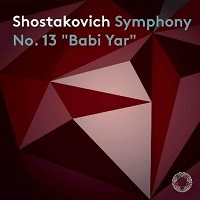 Recording of the Year
Recording of the Year
Dmitri SHOSTAKOVICH (1906-1975)
Symphony No.13
in b-flat minor, Op.113, ‘Babi Yar’ (1962)
Oleg Tsibulko (bass)
Popov Academy of Choral Arts Choir, Kozhevnikov Choir
Russian National Orchestra/Kirill Karabits
rec. 2017, DZZ Studio 5, Moscow, Russia
Reviewed as a stereo DSD128 download from
NativeDSD
Pdf booklet includes sung texts in English and transliterated Russian
PENTATONE PTC5186618 SACD
[58:13]
For SACD purchase details see
review
–
review.
Stream from
Naxos Music Library.
I’m sure it’s not just the fact that I edit and convert Dan Morgan’s
reviews that finds me agreeing with him so often – and sometimes qualifying
that agreement, as here. John Quinn, with whom I again usually find myself
in agreement, liked this recording too, but preferred Haitink, and my money
stays on the powerful Rostropovich recording, which is not very helpful –
it’s unavailable unless you can find a copy of the Olympia CD, or Alto
reissues it –
Summer 2020.
Hearing the Pentatone again in 24-bit sound – a noticeable improvement on
the Naxos Music Library mp3 – I found myself rather more inclined to
Karabits, but it’s still not quite my ideal Babi-Yar.
 Benjamin BRITTEN (1913-1976)
Benjamin BRITTEN (1913-1976)
Peter Grimes
(1945) [137:44]
Alan Oke (tenor) - Peter Grimes
Giselle Allen (soprano) - Ellen Orford
David Kempster (baritone) - Captain Balstrode
Gaynor Keeble (mezzo) - Auntie
Alexandra Hutton (soprano) - First Niece
Charmian Bedford (soprano) - Second Niece
Robert Murray (tenor) - Bob Boles
Henry Waddington (bass) - Swallow
Catherine Wyn-Rogers (mezzo) - Mrs Sedley
Christopher Gillett (tenor) - Rev. Horace Adams
Charles Rice (baritone) - Ned Keene
Stephen Richardson (bass) - Hobson
Chorus of Opera North, Chorus of the Guildhall School of Music and Drama
Britten-Pears Orchestra/Steuart Bedford
rec. live Snape Maltings Concert Hall, 7 and 9 June 2013. DDD.
Synopsis but no texts.
Reviewed as 24/48 download with pdf booklet from
hyperion-records.co.uk.
SIGNUM SIGCD348
[73:32 + 63:47]
Stream from
Naxos Music Library.
This review arose from my failure to review the new Chandos recording of Peter Grimes, with Stuart Skelton as Grimes and Edward Gardner
conducting the Bergen Symphony Orchestra, as chosen by two of my colleagues
as a Recording of the Year. Just as I was beginning to enjoy hearing my
press preview, I was reminded of the problems of opera recordings – and
those of other music continuous across tracks – which don’t offer gap-less
playing. That’s a problem with both Naxos Music Library and Qobuz, on both
of which I happily listen to other music, in mp3 and up to 24-bit
respectively, but I find opera is still a no-no. It’s not beyond the wit of
mankind to have gapless playing – even the basic Windows Media Player,
which used to insert gaps, is now free from the problem.
Though Chandos now send me press previews without the offending watermark,
and though I’m assured that the commercial article comes without the
problem, that put me off listening to their new Peter Grimes and
sent me in search of possible alternatives to Britten’s own recording
(Decca Originals 4757713) and Colin Davis (Decca Opera 4785273). I have the
Britten in a 24/96 remastered format and the Davis on the original Philips
CDs. The Linn download of the Britten –
March 2012/2
– is no longer available, that short-lived arrangement with Universal
having lapsed all too quickly, but
Presto
have a 24/96 download for a reasonable £25.89. I’m amazed that the CDs of
the Britten recording are no longer generally available, though Alto have
reissued it at budget price (ALC2008, around £9).
It’s to those two classic recordings, both now Decca, though the Davis
started its life on Philips, that I shall return, but I was equally
surprised how good this live Signum recording is, and that we seem not to
have reviewed it. There’s the excitement of a live recording, in very good
sound, including 24-bit.
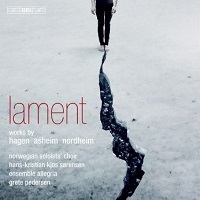 Recording of the Year
Recording of the Year
Lament
Lars Petter HAGEN (b.1975)
Lament 1-3 (2015) [15:0]
Nils Henrik ASHEIM (b. 1960)
Muohta
- Language of Snow (2017) [20:42]
Arne NORDHEIM (1931-2010)
Aurora
(1984) [21:27]
Norwegian Soloists’ Choir/Grete Pedersen
Daniel Paulsen, Terje Viken, Hans-Kristian Kjos Sørensen (percussion)
Ensemble Allegria
rec. 2018/19, Østre Frederikstad kirke; Ris kirke, Oslo, Norway
Reviewed as 24/96 download with pdf booklet from
eclassical.com
BIS BIS-2431 SACD
[59:08]
For SACD purchase details see
review. Stream from
Naxos Music Library.
Regular readers will know that I normally approach contemporary music with
extreme caution, and I had allowed this to pass me by until I read Dominy
Clements’ comments in choosing it as a Recording of the Year: ‘Lament is
the kind of album that can get inside your head and haunt your imagination
long after you’ve heard it. It has a superb balance between drama, beauty,
time suspended and surreal imagery, all performed with utter conviction and
recorded in immersive SACD sound.’ Read ‘24-bit sound’ instead of SACD, and
that sums up my response. We live and learn – at least in part from
colleagues’ reviews.
 Richard BLACKFORD (b.1954)
Richard BLACKFORD (b.1954)
Blewbury Air
(2020) [12:06]
Raphael Wallfisch (cello), Adrian Farmer (piano)
rec. June 2020, Wyastone Concert Hall, Monmouth, UK. DDD.
NIMBUS NI1570
[12:06]
Stream from
Naxos Music Library.
John Quinn’s
review
of this recording ends with an invitation to comment on its availability as
a digital download, though that has been superseded by the fact that the CD
release, originally scheduled for later, has been brought forward by
popular demand. I listened to it in 16-bit sound from Qobuz – there doesn’t
seem to be a 24-bit equivalent – and enjoyed it. It’s available there to
download for £3.99, which seems a reasonable, if not over-generous, price
for a 12-minute recording. So why is it on offer elsewhere for £8 in mp3 and
£9.75 in lossless sound? Amazon UK have the mp3 for £2.97, but that’s
likely not to be at the full 320kbs, so Qobuz seems the best option as I
write, with direct purchase from
Wyastone
the best way to obtain the CD at £4.99. By the time that you read this, things
may have changed; you should check.
What’s not in doubt is the attractiveness of this work by a composer whose
music has made quite an impression, not just on me, recently. Pietà
which Paul Corfield Godfrey
reviewed
in February 2020, has been awarded the Ivor Novello choral prize. (Nimbus
Alliance NI6396, with Canticle of Winter).
 The Protecting Veil
The Protecting Veil
William Butler YEATS (1865-1939)
He Wishes for the Cloths of Heaven 1 [0:38]
John TAVENER (1944-2013)
The Protecting Veil 2 [46:08]
William Butler YEATS
The Mother of God 1 [1:04]
John TAVENER
Mother and Child 2 [7:06]
Frithjof SCHUON (1907-1998)
World Wheel XXVII: ‘I heard the gypsy’s violin play’ 3 [1:00]
Pandit Sultan KHAN (1940-2011)
The Song of Separation and Waiting4 [11:28]
Olwyn Fouéré1; Julie Christie3 (readers)
Sinfonietta Riga/Matthew Barley (cello)2
Matthew Barley (cello), Sukhvinder ‘Pinky’ Singh (tabla)4
rec. Petruskyrkan, Stocksund, Sweden, 19 August 2017; Anglican Church,
Riga, Latvia, 2-3 July 2018.
Texts included
Reviewed as 24/96 download with pdf booklet from
hyperion-records.co.uk.
SIGNUM SIGCD585
[67:29]
For CD availability see Recommended
review.
Stream from
Naxos Music Library.
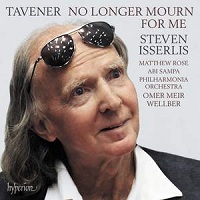 No longer mourn for me and other works for cello
No longer mourn for me and other works for cello
John TAVENER (1944-2013)
Preces and Responses (2013, arr. Steven Isserlis) 1 [12:19]
The Death of Ivan Ilyich (2012, words by Tolstoy) 2 [27:05]
Mahámátar
(2000) 3 [15:48]
Popule Meus
- a Meditation (2009) 4 [12:18]
Three Shakespeare Sonnets: Sonnet LXXI. No longer mourn for me
(2010, arr. Steven Isserlis) 1 [4:27]
Steven Isserlis (cello) with
Caroline Dearnley (cello), Chiara Enderle (cello), Matthew Huber (cello),
Vashti Hunter (cello), Bartholomew LaFollette (cello), Amy Norrington
(cello), David Waterman (cello)1
Matthew Rose (bass)2
Philharmonia Orchestra/Omer Meir Wellber2, 4
Steven Isserlis (cello), Abi Sampa (Sufi singer), Trinity Boys Choir 3;
rec. Balliol College, Oxford, 8 September 2017; All Hallows, Gospel Oak,
London, 17-18 December 2019. DDD.
Texts included
Reviewed as 24/96 download with pdf booklet from
hyperion-records.co.uk.
HYPERION CDA68246
[71:59] For CD availability see
review
–
review.
It seemed that Steven Isserlis had The Protecting Veil all sewn
up, except that his recording with the LSO and Gennady Rozhdestvensky
appears to be download only, in all three formats in which it’s available –
the least expensive is on the C20 Classics twofer 2376912, an all-Tavener
coupling –
review. That’s another example of something that I lament elsewhere – the massive
axe which Warner took to their EMI and Virgin catalogues, with some CDs
disappearing completely, others available only to download, often more
expensively than when on disc. (That said,
Amazon UK
still seem to have a few copies of the twofer on CD.)
Now the Signum recording challenges Isserlis’ hegemony in The Protecting Veil, coupling it with poems which were among the
composer’s favourites, and Isserlis’ new recording of other Tavener music
places us further in his debt – and Hyperion’s for bringing us the first
recordings of all this wonderful music. Who would have thought that a set
of preces and responses, composed for use in the Anglican liturgy, would
have sounded so compelling when transposed for eight cellos? Add the fact
that extra music for cello was needed to fill the CD, so Isserlis set about
transcribing this and the closing Shakespeare sonnet, and the effect is
even more remarkable.
Equally remarkable is the blend of traditions in Tavener’s music, including
a composition performed by a Sikh tabla player on Signum and on Hyperion
the Sanskrit-inspired hymn to the Mahámáter, or Great Mother,
adapted in praise of the Virgin Mary and chanted by a Sufi singer. If you
already have a recording of The Protecting Veil, you should need
no urging to go for the Hyperion. Otherwise, start with the Signum and you
will soon be adding the other to your collection. In both cases, the
Hyperion download in lossless sound is significantly less expensive than
the CD and the superior hi-res 24-bit costs very little more. As always
with Hyperion, the booklets are included – both are very valuable.
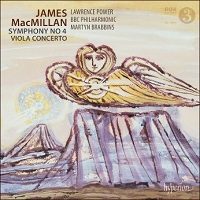 Recording of the Year
Recording of the Year
Sir James MacMILLAN (b.1959)
Symphony No. 4
Viola Concerto
Lawrence Power (viola), BBC Philharmonic/Martyn Brabbins
rec. May 2019. DDD.
HYPERION CDA68317
– from
hyperion-records.co.uk
(CD, 16- and 24-bit downloads)
Also included in
Hyperion at 40 article.
For CD purchase details see Recommended –
review
–
review
–
review
I forecast this release in
reviewing
a Coro recording of MacMillan’s Symphony No.5 and The Sun Danced.
In the event, three of my colleagues included everything I wanted to say,
so I didn’t add my two pennyworth.
My uncompleted review included a reflection on the possible influences,
which added to rather than detracted from my enjoyment: We are summoned by
bells into the one-movement Symphony No.4. If this is a nod in the
direction of Arvo Pärt, it’s not overdone. If there is influence there, as
so often with MacMillan’s music, it hovers subtly on the verge of the
listener’s awareness and it’s fully absorbed into his own voice. Later
there are moments when I could have sworn a piece of renaissance music is
making its influence but I couldn’t quite place it – the booklet mentions
the Missa Dum sacrum mysterium by the sixteenth-century composer
Robert Carver, whose music, which deserves to be heard alongside his
English contemporaries, MacMillan loves and promotes.
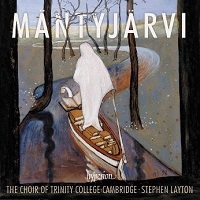 Recording of the Year
Recording of the Year
Jaakko MÄNTYJÄRVI
(b.1963) Choral Music
Ave Maria d’Aosta
(2004) [2:44]
Stuttgarter Psalmen
(2009) [28:05]
Benedic anima mea Domino
(1994) [4:04]
Pulchra es
(2018) [2:58]
Trinity Service (2019) [28:03]
O magnum mysterium
(2007) [4:50]
Rachel Coombs (soprano), Molly Noon (soprano), Fiona Tibbles (soprano),
Edward Cunningham (tenor), Ben Mortishire-Smith (bass)
Choir of Trinity College Cambridge/Stephen Layton
rec. Trinity College Chapel, Cambridge, January 2018, January 2019 and
January 2020. DDD.
Reviewed as 24/96 download from
hyperion-records.co.uk.
Texts and translations included.
HYPERION CDA68266
[70:54]
For CD purchase details see
review.
To the list of contemporary composers writing fantastic choral
music, add the name of Finnish composer Jaakko Mäntyjärvi. A singer,
conductor and translator as well as a composer, his output is fairly
evenly divided between the secular and the sacred. I have yet to hear
any of the former, but the sacred, as evidenced by these performances
from Trinity College, for whom he composed a set of Evensong music for
Trinity Sunday last year, is well worth becoming acquainted with.
Finnish names may not be the easiest for notoriously language-shy
English speakers to pronounce, but, like that of Rautavaara, with whose
music we have become accustomed over a period of time, Mäntyjärvi's
music speaks for itself – and speaks volumes.
Though his music is sung by choirs world-wide, this seems to be only the
second recording entirely devoted to Mäntyjärvi’s work. The other, entitled Salvat 1701, was recorded by Tapiola Chamber Choir and Hannu
Norjanen for the Alba label in 2000 (NCD18). It’s described as ‘a
semi-dramatized concert or choral drama, or perhaps a hymn-oratorio based
on the Finnish Old Hymnal of 1701’.
I’ve mentioned Rautavaara, but the names of Eric Whitacre – a new recording
of his The Sacred Veil on Signum SIGCD630 is also available to
download from
Hyperion
– Morten Lauridsen, John Tavener and Arvo Pärt, mentioned in the Hyperion
notes, are even more relevant in setting Mäntyjärvi’s sacred music in context.
He’s certainly not a one-style-fits-all composer, as the opening works
demonstrate. The Ave Maria d’Aosta achieves its effect economically
yet luxuriously. Every note of this short but richly harmonic
setting makes its effect: this is one of the richly robed angels of the
Annunciation from a renaissance painting – Crivelli, perhaps – but his
words come through to Mary and to us with considerable clarity, thanks to
the proverbial enunciation of Cambridge college choirs.
Then, with the first of the Stuttgart Psalms, it’s as if words and
music are thrown down to smash on the floor like the covenant that we have
broken with God. If the Ave Maria is comfortable and comforting, this is
just the opposite. Now, instead of harmony and economy, the words Warum toben die Heiden? (Why do the heathen rage?) are cast at us
like daggers of ice.
These are the words of Luther’s German Bible sounding as shockingly direct
in this guise as they must have done in Luther’s day to congregations used
to hearing Latin which they didn’t understand. One old man was so confused
that he fumbled and dropped the communion host when it was given into his
hands. The music sounds uncannily similar to Hoffnung’s famous parody of
the avant-garde style, Ja-ja’s Punkt Kontrapunkt. Yet, while
Hoffnung achieves his put-down of Schoenberg, Nono and all their kind,
Mäntyjärvi is searingly direct. If anything, the second of these psalms, Mein Gott, mein Gott, warum hast du mich verlassen? (My God, why
hast thou abandoned me?) is even more searing.
The return to a more economical style in the dancing setting of Benedic anima mea Domino and the sensuous, mystic Pulchra es (tracks 5 and 6) is like a soothing massage after a
hard work-out – not that I’m much given to the latter.
The Anglican service of Evensong may date back only to the first English
Prayer Book (1549), but, as a conflation of the earlier services of Vespers
– usually called Evensong in England even before the reformation – and
Compline, it seems timeless. Cranmer’s language, itself flowing in sync
with the Latin originals, is less likely to be set aside for shopping-list
English here than in celebrations of the Eucharist. The Trinity Evensong is
the longest work on the album, and the challenge to compose music that is
clearly contemporary but relating to the past is strongest here.
Mäntyjärvi’s setting opens with an Ave Maria as introit, the
opening Preces, Psalm 128, Magnificat and Nunc Dimittis,
Responses, Lord’s Prayer, Responses and Collects, including that for
Trinity Sunday – the college’s patronal festival – the anthem O Lux Beata Trinitas, and the close.
The Magnificat and Nunc Dimittis were composed
specially for the Trinity Service; unusually, the latter, the shorter of
the two texts, is the longer and more impassioned setting. Dare I
suggest that these canticles might become the Evensong of the 21st century to match
Herbert Howells’ Anglican music in the second half of the twentieth or that
of John Merbecke who published the first settings for the reformed service
in 1550?
Everything fits, including the eerie cover image, which I originally
mistook as depicting The Isle of the Dead.
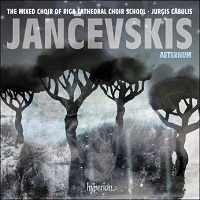 Recording of the Year
Recording of the Year
Jēkabs JANČEVSKIS (b.1992)
Odplyw
(‘Ebb Tide’) [7:05]
Atsalums
(‘Coldness’) [6:33]
Mater amabilis [5:00]
Aeternum
[5:53]
O lux beata Trinitas
[9:03]
When [10:13]
Ar zvaigžņu kluso gaismu
(‘Silent Starlight’) [4:22]
The Button [8:47]
Mixed Choir of Riga Cathedral Choir School/Jurģis Cābulis
rec. 2018/19, Riga Recording Company A Studio and Latvian Radio Studio 1,
Latvia
Reviewed as 24-bit lossless download with pdf booklet from
hyperion-records.co.uk
HYPERION CDA68328
[56:59]
For CD purchase details see
review
–
review
This is yet another recording of ethereal music from a composer I had not
even heard of before Hyperion treated us to it. I’ve already added their
Mäntyjärvi recording to my regular listening; here is yet another, younger,
rival to Arvo Pärt and Pēteris Vasks. It must be something that they put in
the water in the Baltic countries.
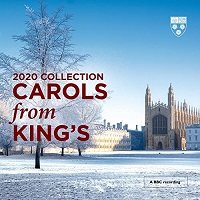 Carols from King’s (2020 Collection)
Carols from King’s (2020 Collection)
GAUNTLETT: Once in Royal David's City [5:13]
Andrew CARTER: A Maiden Most Gentle [3:03]
MACONCHY: There is No Rose of Such Virtue [1:57]
Traditional, Ralph VAUGHAN WILLIAMS: Herefordshire Carol (This is the Truth Sent from Above) [2:34]
Traditional, Arthur SULLIVAN: It Came Upon the Midnight Clear [3:54]
Philip MOORE:
The Angel Gabriel [3:54]
LEIGHTON: Three Carols, Op. 25: No. 2. Lully, Lulla, Thou Little Tiny Child
(Coventry Carol) [3:12]
Trad.:
Sussex Carol (On Christmas Night) [2:26]
Walford DAVIES: O Little Town of Bethlehem [4:47]
Trad.: Ding! Dong! Merrily on High [2:11]
RUTTER: Candlelight Carol [4:15]
MENDELSSOHN: Hark! The Herald Angels Sing [3:36]
King’s College Choir, Cambridge/Daniel Hyde
rec. live 2019. DDD.
Reviewed as streamed in 24/96 sound.
No booklet.
KING’S KGS0048
[41:02] Download or stream only – from
Amazon UK
-
Presto. Stream from
Naxos Music Library.
This should have been included in my recent
Christmas round-up, but it appeared
just too late. In any case, these recordings, from the 2019 Nine Lessons and Carols and its television sibling, are
self-recommending. The short playing time comes with a reduction in the
download price – pay no more than £5.60 for lossless sound; don’t pay £7.89
for inferior mp3.
